If you would like a printed copy of any of our back issues, then they can be purchased on Farm Marketplace. You can also download the PDFs or read online from links below.
-
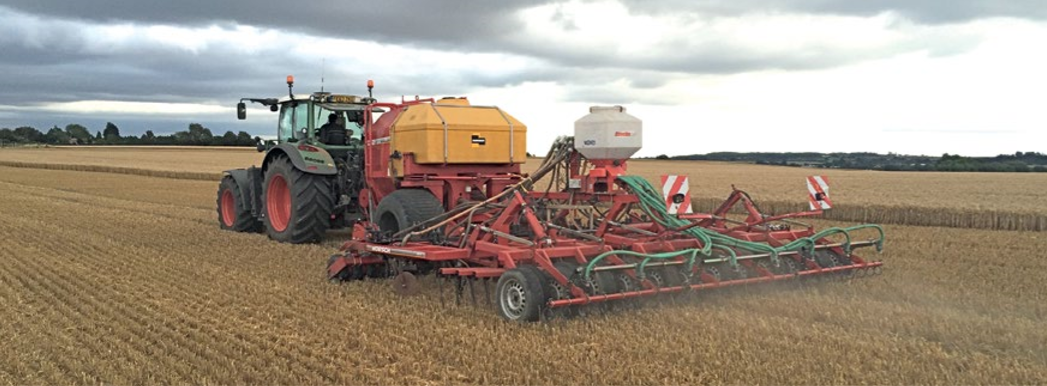
How To Start Drilling For £8K
Clive Bailye’s seed drill of choice is his 6m John Deere 750A , which has been used exclusively for 3-4 seasons. Last year, with an increased acreage, the founder and publisher of this Direct Driller magazine thought a second seed drill was necessary. Having just the one machine was a risk and in a difficult season would mean drilling was delayed. He looked around and found a good condition Horsch CO6 tine drill advertised in Germany.
Words and pictures by Mike Donovan
After delivery he rebuilt the coulters to a narrow profile so as to reduce soil disturbance. He says the tine drill is very useful driling after straw crops such as osr and also through the straw on second crop cereals.
Buying the drill from a German farmer was not particularly complicated, and provided him with a higher spec machine than Horsh sell in the UK. The seed dart tyres are much wider, and the machine is fitted with blockage monitors as well as full width front packers and also a liquid fert application system.
A sheaf of photos were taken, and Clive then asked for some of specific parts to show wear. The deal was done at under £5,000 which Clive says is the market value of these machines which are too large for small farmers to buy. Original owners like to buy new and sell when the machine is still in good condition.
Narrow tines with wear tiles
@Clive knew he wanted to make changes, substituting the Horsch tines and coulters for something far narrower, and has ended up getting his own design of tine made, which has a wear tile made from Ferobide, far harder than tungsten. The drill is on the farm primarily for osr and 2nd crop cereals drilled into chopped straw and the 25cm spacing is okay for these crops.
Comments on Clive’s on-line forum, TFF, said the drill many not be so good with beans, as the slot is a mere 12mm wide. And in barley the spacing may well be too wide as it needs to be thick. Clive points out that the seed pipe can actually be a bit wider than 12mm as it is in the shadow of the point. It would be good to have the option of using it for beans.

Above left: The cheap CO6 is being calibrated ready for its first outing

Above right: The adapted Horsch is being filled by the home built drill logistics trailer with seed and liquid starter fert.
Getting around the German instructions
The Horsch came, of course, with a control box and instructions in German. More on-line discussion revealed that English instructions were available on the Horsch website, and another explained that Horsch was sourcing some of these parts from Agton in Canada anyway. Zealman from New Zealand explained that the button marked with callipers should be held down for around 5 seconds. The menu is where you adjust the tramline sequence, valve layout and row numbers.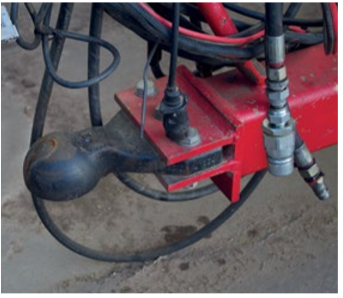
Ball hitch is a continental standard and provides a positive connection between tractor and drill

The Stocks Wizard has a rotor modified for Avadex which otherwise leaks everywhere
A Stocks Wizard is on the back of the drill and used for Avadex. Here again the knowledge of actual farmers is helpful. Alistair Nelson warned that the rotor and the surrounding shroud need to be changed, and he got good advice “from Rick at Stocks”. Clive has the same setup on the 750A and says that the Avadex leaks everywhere unless the modification is made. The drill was acquired and modified in 2016 and the results have been excellent.
The machine went through the residue without many problems and having the second drill has meant more timely planting. Clive has shown that moving into No-Till is not the expensive exercise so many farmers think it might be. The total cost, after modifications which included replacing all tines and coulters, was under £8,000.
Author Mike Donovan writes: we have featured a number of home made direct drills in @Practical Farm Ideas, and are always interested in seeing more. Please contact mike editor@farmideas.co.uk or 07778877514.
-

Weed Suppression With Cover Crops: It’s All About Biomass
Written by Dr. Bob Hartzler and Meaghan Anderson of Iowa State University
One important benefit of cover crops to our production system is providing an alternative selection pressure on weed populations. Cereal rye has the best potential to suppress weeds because it accumulates more biomass than other cover crop species. Weed suppression is closely related to the amount of biomass at the time of termination (Figure 1).

The importance of biomass on weed suppression can be easily observed in a demonstration evaluating suppression of waterhemp by cereal rye developed for the 2020 Farm Progress Show. Treatments represented no cover crop, an early termination when rye was 6-8 inches tall (900 lb/A), and late termination when rye was flowering (10,000 lb/A1). Three weeks after planting there were dramatic differences in both waterhemp emergence and growth (Figures 2-4).

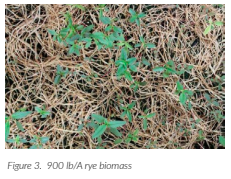
The low rye biomass treatment reduced waterhemp growth more than it did emergence, whereas the high biomass treatment dramatically reduced both emergence and growth. Waterhemp emergence was delayed more than two weeks in the high rye treatment compared to the 0 and 900 lb rye treatments. In the high residue treatment, \c seedlings had to navigate through an inch of mulch to reach full sunlight (Figure 5).
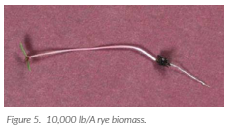
Hypotocotyl needed to elongate 1.25 inches to get through the rye mulch.
Many factors influence the biomass produced by cereal rye, most important are planting date and termination date. Rye’s tillering ability reduces the importance of seeding rate except in situations with late planting. A minimum seeding rate of 1-1.5 bu/ac is typically recommended. Increased seeding rates will provide more consistent stands when rye is seeding using an airplane or other broadcast methods, as well as when seeding occurs in October or later.
For most farms, cover crops provide an opportunity to achieve more consistent weed control and lower selection pressure for herbicide resistance, rather than allowing significant reductions in herbicide use. Farmers desiring to reduce herbicide use must manage the cover crop to maximize weed suppression. Target early seeding dates, typically before late September. Seeding with a drill typically results in the most consistent stand across crop fields. Termination timing should be delayed past mid-May to ensure rye biomass is maximized for the most persistent weed suppression.
110,000 lbs/A of rye biomass is higher than typically achieved in Iowa. The rye was drilled after harvesting corn for silage, and termination was delayed until mid-May.

-

Farmer Focus – Clive Bailye

If I was ever to write the script for a farming based horror movie I think the title may simply be “2020’’ ! Last time I wrote it was December 2019 and we were only 60% through our autumn drilling campaign. Well behind our usual planned October finish. The new 12m Horsch Avatar had been parked up and our farm workshop Co6 and front hopper tine drill was working in any available dry spell to complete the remaining workload. The Avatar coulter had been impressive in the unusually wet conditions, not blocking in conditions where I’m sure our 750a would have but ultimately its limiting factor was the weight of the seed cart on wet soils.
With a full 12/36m CTF system in place here any soil damage caused by weight on wet, fragile, soils is at least confined to a known and small % of the land which, if necessary, can be targeted to repair. However, repair means soil disturbance I would rather not do so the lightweight and balanced CO, able to run a low tyre pressures seemed the better choice in the extreme conditions. Also of note was the correlation between how long a field had been farmed under conservation agriculture principles and ability to drill, the longer term soils not only able to carry the weight of establishment machinery far better but far less prone to smear against the disc of the avatar or the tine of the C0.
Despite lacking the versatility of a disc when it comes to dealing with huge amounts of green cover and surface trash, on our soils a tine is better when soil is wet, and the less consolidated surface seems to give better establishment later in the season. Over the years of evolution of our tine drill we have experimented with various tine solutions. When first converted we used the Metcalfe points, I was attracted by their narrow profile of just 12mm and low price tag compared to others but quickly found on our stoney soils that the tungsten wear tile would often break off long before the point was worn out and that narrow profile led to very rapid seed tube wear and issues flowing larger seeds like peas and beans.

I set about creating my own modified version, initially this was just a wider version (15mm) using a Ferobibe wear tile that could be replaced with a farm workshop Mig welder. Unlike the tungsten, soil flow still created wear issues with the seed tubes so later protective side plates were added but I was never 100% happy with the design.
In 2019 I had the opportunity to try some Bourgault VOS openers, initially we fitted the twin row 100mm points, the quality was impressive and they worked well but 100mm was too much soil disturbance for my liking so we moved to the 19mm single shot point which seem absolutely perfect, low disturbance yet wide enough to flow even the largest of bean seed and with no seed tube to wear with it being internal to the point. I think this will be the solution we stick with going forward, they were pushed to the limits this year in conditions I hope to never see again, in combination with the Horsch Partner front hopper I think they were the only reason that on February the 15th we finally managed to complete 100% of the “autumn” wheat and bean establishment workload.
Having the right tools for the job and the right soil is only part of the picture, without the commitment, skills and tenacity of good staff no farming system can ever be successful, The herculean effort made by everyone here this season was exceptional, they worked at every available opportunity, safely and efficiently with their usual attention to detail. The sense of achievement by all, against the odds and conditions felt like sweet victory making the second part of this horror story even harder to swallow …

Despite the difficulties of autumn at least our OSR area all looked good, locally a lot of crops had been destroyed by CSFB not long after drilling, yet ours had all made it through winter and although not exceptional looked ‘alright’. As soil temperatures warmed and first nitrogen was applied though it became clear all was not good. Closer inspection revealed stems badly infested with CFSB larvae, there was no way the crop was going to yield, although hard to accept it was a write off and clearly best replaced with a spring crop of linseed creating a significant increase to our spring workload but at least with our low input, low risk approach to OSR the financial impact of losing the crop was minimised with just farm saved seed, a herbicide and 1/3rd of the nitrogen applied we can simply call it a cover crop and move on !
The future of OSR on this farm is doubtful, we seem to have got away without CSFB issues longer than some but it was inevitable it would hit us eventually, pests do not respect farm boundaries or hedgerows so regardless of IPM or soil health on individual farms there is nothing an individual farmer can do to remain immune to this problem.

Unlike many I believe the ban on neonicotinoids is not entirely responsible for this issue. In fact, I think this is a clear example of how unsustainable modern agriculture has become when an entire crop can seemingly no longer be grown. The blame in my opinion for this loss sits firmly at the feet of poor rotation, agronomy and often blatant, historic, disregard of IPM. Afterall I am certain the Romans who bought this crop to the UK farmed without seed dressings and pyrethroid. Yet in just one generation we seem to have made something possible for thousands of years, impossible. If that doesn’t make you question the overall direction of modern farming and its impact upon our environment, then it should, what crop will we be crossing off the options list next I wonder if we don’t change? Blackgrass problems anyone?
In mid-March the rain that had started on September 20th finally stopped rather ominously on Friday 13th of March. A total of 580mm had fallen through that time and only 8 days had no rainfall at all making it even more remarkable that we had somehow got that autumn workload complete. Soils started to dry, and we were soon able to get the spring crop establishment completed in good time and condition. Grateful to finally get some dryer condition to work in establishment was quick and simple compared to the trials and tribulations of the winter. We joked about a drought …….. and then it happened!
It was 82 days later, on June 3, when we had our next rainfall. At this point the wheat was almost dead. Tillers had been dropped and yield potential irreparably capped, spring crops had emerged and developed slowly, I think in some cases had we cultivated to establish them they maybe never have emerged at all. The farm really did not look great, the only consolation being a country in covid 19 lockdown at least I didn’t have to look at it very often!
I’m the first to criticise farmers for moaning, let’s face it, if you can’t deal with unfavourable weather then farming probably is not the best occupation to choose. I prefer to focus on things we can control as managers rather than things we can’t. I chose to accept this season as a challenge, if you can win a game of poker with a bad hand then surely you can still make a margin growing crops with bad weather?
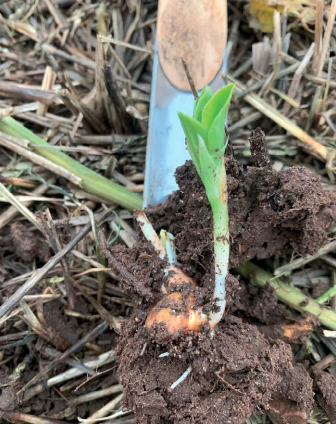
The simplicity of the low fixed cost structure business I have set out to build suddenly felt more prudent that ever with a small payroll and machinery fleet to finance the next focus was on adjusting the variable costs to fit potential.
Fortunately we had applied 60% of the planned N to our wheat early, as the hot, dry conditions persisted it was fear of scorch and damage that led the decision to apply no more but ultimately as tillers aborted it was yield potential finally made the 60% into 100% of planned application. It was a similar story for other inputs, a cheap fungicide application made at T1 timing became all that was needed to keep wheat clean until the rain finally returned in mid-June. Spring crops needed just fertiliser and herbicides; I don’t think we have ever had a year where our usually very busy sprayer has been parked in the yard quite so much.
The result has been an extremely cheap year, ultimately a very simple year. Although we are unavoidably heading into a lower output harvest than we have seen here for many years I think this could be one of the best farm management years I have had, there is not a single decision I think I would change this year, not a single opportunity missed and I don’t think I have ever been able to say that before. I’m looking forward to harvest and remain hopeful that this farming horror story could just have a happy, ie. profitable, ending!
-

Manufacturers In Focus…

MANAGING STUBBLES WITH THE RAZORBACK RESIDUE MANAGEMENT SYSTEM
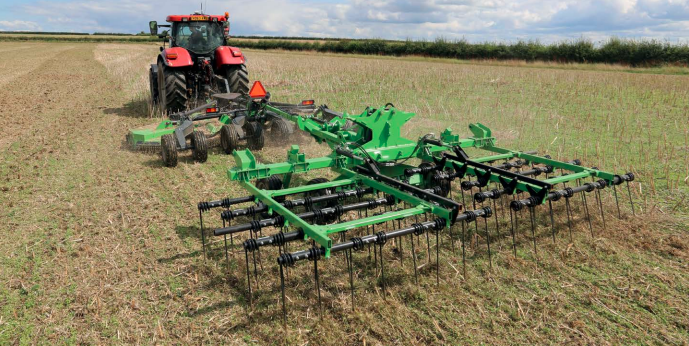
Headed by Martin Lole, a farmer and engineer who has enjoyed a successful career as the driving force behind several leading UK vegetation and conservation agriculture brands, Razorback draws on over 100 years of combined industry knowledge shared by our experienced engineering, sales and service teams. Designed with superior quality, strength and versatility in mind, Razorback products undergo extensive testing during the development process to give operators piece of mind, knowing they have invested in tried and tested solutions. It’s on our own trial farm in Worcestershire that we developed a number of residue management systems including the Auto-Level hedgecutter with Co-Pilot technology as well as our latest development the RT Series rotary mower and RH Series trailed harrow.
Award Winning Slug & Weed Control
Launched earlier this year at LAMMA, the mower and harrow combination was developed to compliment direct drilling establishment by providing a reliable cultural control method for minimising weed and pest pressure. In recognition of this, the duo was awarded Gold at the LAMMA Innovation Awards in the Arable category and went on to win the LAMMA Founders Award for best overall innovation at the show. The judges commended the innovations ability to actively encourage a flush of weeds ahead of drilling and its potential for reducing reliance on molluscicides as a result of disrupting slug habitats. The mower and harrow combination work by consolidating two passes into a single operation, saving users time and diesel.
Stubbles are chopped and distributed evenly across the full working width whilst the trailed harrow shatters residue to significantly reduce slug habitats, providing a cultural control method and reducing chemical applications.
The trailed harrow features five rows of adjustable extra stiff 28” tines that offer high frequency vibration which enhance the shatter action to accelerate straw decomposition and stimulate weed chit. When following the RT Series rotary mower, stubbles can be topped, distributed and the surface stimulated to promote a flush of weeds and volunteers ahead of Autumn drilling in one pass.
By encouraging an even flush of weeds and volunteers’ growers can make better use of their available chemistry to achieve an effective weed kill.
Versatility and high spec as standard
In addition to its arable applications, the Razorback mower and harrow combination suits a wide variety of tasks including tidying up headlands and reinvigorating grassland by removing thatch from the lower levels of the sward.
Available in 5 and 7.5 metre widths both the mower and harrow are designed and built here in the UK. The RT Series rotary mower features double skin construction, full length replaceable skid shoes, and high specification Bondioli and Pavesi gearboxes and driveshafts. Unlike many rotary mowers, gearbox skirting protects the gearbox’s shaft seals and bearings from residue, string and wire which can cause unnecessary damage if left open to the elements. It is design elements like this that makes us proud to offer machines of a superior build quality that will stand the test of time.
For more information on any of the products in the Razorback range get in touch with our team on 01905 347347.
Scan the QR code to watch the Razorback system in action here:

-

Farmer Focus – David White

Thoughts and lessons learned from the season. Where to start???
Well the earth on the farm went from very wet over winter to very dry. April was the sunniest it’s been since 1929 I believe, with the drought being broken towards the end of the month by some very welcome rain. We have been treated to the clearest air and the bluest skies that anyone has seen for many decades. It’s a shame that it’s taken a global pandemic and shutdown of industrial operations and carefree travel to make the change to the environment that we have been aware is needed for a while now.
May continued dry and we start to think that we need some vapour trails and upper air pollution to create conditions for rain to happen again! Whilst we do all we can to improve soil heath and structure and increase SOM to improve drought resistance still on light land the effect of insufficient precipitation combined with high temperatures and high winds have drained yield potential. So thoughts turn to combating drought and coincidentally on the internet popped up an article The Drought Myth, An Absence of Water is Not the Problem by William Albrecht.
www.appropedia.org/Drought_Myth
which discusses the role of nutrition in combating drought. I have been adding trace elements to spray applications at every opportunity but have still found that the absence of water is a big problem. More work needed here. Even the more specialist bio extracts appears to have made no difference. Soil structure and subsoil is no doubt very important and I’m always reminded of this by the route of a pipeline which crossed a field well over twenty years ago. The crop is always stunted and looks hungry (see pic) but the same soil was replaced in the trench that was removed, just in a different order.
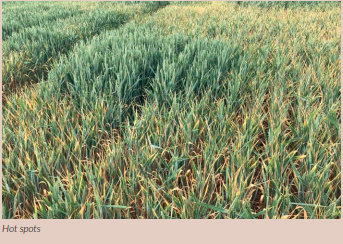
On the worst field I have for “hot spots” (see pic) the difference in crop changes dramatically in just a few inches. You would not think it was possible as we expect roots to roam for moisture and nutrition on top of their increased efficiency through association with Arbuscular Mycorrhiza Fungi. I will taking soil samples from 0-300mm and 300-600 analysed to see what differences can be found.
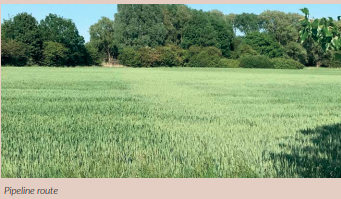
On top of how we physically farm the soil we are trying to reduce crop inputs, jump off the treadmill of nannying crops with insurance PPPs and let crops on our healthier soils with an increased number of beneficials stand up for themselves.
I have had success with this approach again this year with insecticide free crops of wheat and rape but less success with reducing fungicides. Learning where we can successfully cut back is still a work in progress. I refuse to be persuaded to apply a T0 to wheat preferring it to stand on its own feet but it’s surprising how quickly patches of yellow rust started to appear on my varieties of GP1 wheats. These being Zyatt, Solstice or Skyfall or a blend of the three. A T1 needed to be applied very swiftly, and to keep on top of the problem a well timed T2. Nothing saved there then!
Autumn insecticides are avoided when ever possible but we do need to be aware of the risks from the green bridge between crops, and on one field of wheat the aphid population that inhabited the volunteer oats and possibly were living in the excessive amount of wet chopped straw has infected the wheat fairly badly despite a poorly timed (with hindsight) insecticide application. As part of our IPM we really need to be able to get aphids tested to see what disease they are carrying and have regional data on this.
Spring seedbeds were a challenge following the excessive amount of winter rainfall but as a rule better (dryer) where the cover crops had been left growing until early February than sprayed off before Christmas, in this case to get a second flush of Blackgrass. The ground does need to be dry enough to crumble into the slot or at least not mush back together again after the seed is placed and in the early sprayed off field it was not. With hindsight again I should have moved this a couple of inches deep to let it dry but had no machine for the job other than going over it with the Horsch tine drill. To that end I’ve found and purchased a super cheap new 3mt disc and packer machine which I’m fitting a seeder box to. This will perform three tasks, 1. covercrop establishment, 2. light movement of any seedbed to dry it if necessary and 3. mechanical covercrop destruction to reduce reliance of, or number of lts/ha required, in producing a clean environment to drill into of glyphosate. This is something I trialed in late autumn 2018 with a very lovely but expensive Lemken Rubin machine with some success.
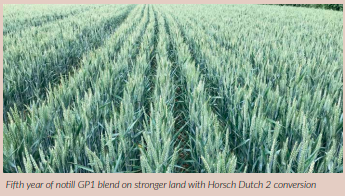
Headlands. I’m surely not the only one that has headlands that look better than the field! I haven’t quite worked out why this is but on a traditional cultivation system headlands were always the poor relation, especially in a wet year.
Thoughts around this are, better consolidation, in a no-till system is this possible? Fewer slugs due to consolidation. An effect of some type from the surrounding flora. Extra nitrogen due to me not cutting back the rate enough on the headland setting, but half of the N is applied as liquid! Drilling more slowly, or something else. Thoughts appreciated via Twitter or Farming Forum/BASE UK forum if you can please.
So to sum up. The farm doesn’t look too bad and with a well timed rain and a little less heat and wind in May it would have looked very good. I can’t blame the no-till system, now it it’s fifth year here, for any crops that look less than perfect other than some spring barley and that was down to poor judgement on the day by me. The better well bodied land has the better crops due to holding more moisture than the land with sand under it. The ability to chose either the disc or tine drill depending on circumstances has been invaluable with the JD750a doing a fabulous job in green catch crops and the Horsch Dutch conversion likewise into wet chopped straw on wheat after oats or second wheats. In fact the no-till system afforded me the ability to drill 130% of planned wheat area in what was one of the most difficult autumns we can remember.
Finally the desire to farm using many fewer artificial inputs is very laudable but there are risks when we back to rein back too far.
What is holding us back at the moment is the risk/reward balance, something organic farmers have much better sorted and to help progress Regenerative Agriculture more quickly premiums that support the way that we are farming would be helpful.
-

Field Lab: Organic Wheat Varieties Part 2 – The Results
Results and Discussions – Spring Assessments

The above table shows different crop traits that can be easily measured around stem extension, a key growth stage signalling the end of the Foundation Phase and the start of the Construction Phase. Several of the traits relate to crop vigour in the spring, which is desirable for organic farming, offering greater competition from the crop against weeds and for resource capture.
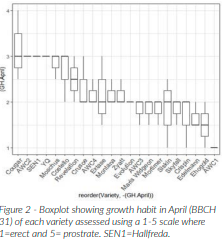
Extase and AWC3 showed consistently above average positive spring traits, whilst Evolution performed consistently below average across these traits. Many other traits contribute to yield and quality and it should be noted that despite it’s apparent deficiency in terms of spring vigour, Evolution was the highest yielding variety in the plot trial.

Growth Habit
A relatively simple assessment to perform, varieties can be classed according to five growth habit groups from 1 (erect) to 5 (prostrate). This trait may have implications for the crop management as shown below in the farmer rankings with different weeding strategies dependent on certain growth habits e.g. erect types may be better for inter row hoeing. The trait may also provide an indication of competitiveness, with erect types generally taller and the prostrate types generally providing greater groundcover. Which of these traits may be most useful will depend on a number of factors including the farm (soil, weed community etc.) and the year.
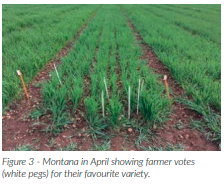
At a field lab meeting in April, farmers were given the opportunity to vote for their favourite variety based on the phenotypes in front of them. Most of the farmers expressed a preference for varieties with high biomass and good groundcover. Montana and AWC1 (Mv Fredericia) were voted the best varieties though for different traits. Montana was selected for its good ground cover, greenness, even spread and moderate height while AWC1 was selected for being tall and open making it suitable for inter row hoeing. This result illustrates the difficulty in selecting a one size fits all variety or so called ideotype for organic farming. The farm and crop management will heavily influence which variety is best suited for that system.
Late flowering/Early milk Assessments in July
Key traits measured in July around late flowering/early milk give an indication of varieties with mostly positive attributes for example disease resistance for the three main foliar diseases, good crop cover and high ear numbers. While ear density is usually the most important of the three yield components, it is not strongly linked with yield here, with grain number per ear and individual grain weight (size) also important. Some varieties with a large number of ears also had rather small ears (i.e. lower grain numbers per ear) and smaller grain. Crop height is generally regarded as an important trait in organic production with taller crops usually deemed desirable for their additional weed smothering and competitiveness.
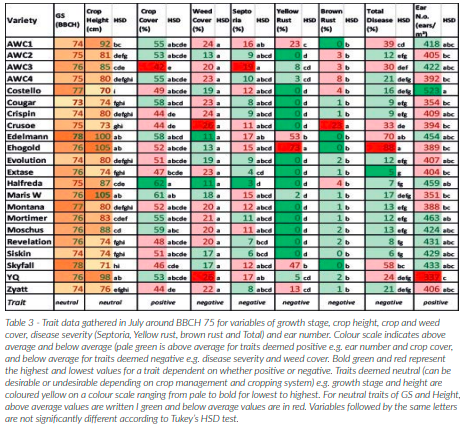
Of course, crop canopy and cover are also important and height in and of itself may not always be beneficial if the canopy is also very open allowing weeds to compete. For this reason, final height has been treated as a neutral trait particularly given farmers comments about lodging and certain mechanical weeding practices (e.g. weed surfing) that may put taller crops at a disadvantage, or at least make them less desirable. On highly fertile ground taller crops may lodge with associated reductions in yield and grain quality possible. However, in certain circumstances where there is a large and competitive weed community, taller crops can be the difference between satisfactory and very poor yields.

Disease
The chart above shows the mean disease severity for the three most important foliar diseases. While disease is often considered by organic arable farmers to be of less importance than either nitrogen and/or weeds in terms of yield limiting, all things being equal, varieties with higher disease resistance will always be desirable. Increased nitrogen availability in conventional trials limits the relevance of so called “untreated” data as there is a known link between nitrogen and disease susceptibility, particularly for Septoria (Loyce et al 2008). Having said that, untreated yields and the relative yield compared to control varieties, used by the RL can be a useful indicator of overall disease tolerance or resistance, with those untreated varieties showing the lowest relative yield reduction compared to treated controls likely to be suitable for organic production. In fact, the best performing varieties in terms of yield also tended to show the lowest mean disease severity e.g. Crispin, Siskin, Evolution, Revelation, Hallfreda.
Varieties with high relative untreated yields on the Recommended List will have high disease resistance and are likely to be highly desirable for organic farming though this data comes from the testing regime for the RL with full fertiliser and herbicide inputs, offering only limited relevance to organic farmers. What is clear is that having a high relative untreated yield is not enough for varieties since they must have a high relative treated yield in order to be considered for the RL.
This means that varieties that show a promising relative untreated yield, and therefore potential suitability for organic farming, can be rejected on the basis that yields are not high enough compared to control varieties under treated (with fungicide), high input conditions. This is clearly an issue for the organic sector with the variety Mortimer offering evidence of this bias. Mortimer has performed consistently well in the organic plot trials for the last two years showing good disease resistance and high yields and has shown promise in terms of its untreated relative yields in NL trials. However, due to its below target treated relative yields the variety has fallen from commercial production despite it’s high disease resistance scores and potential for organic farming.
An argument could be made for a small additional RL that only required high relative untreated yields for varieties to qualify as this would keep additional disease tolerant varieties in circulation and would increase the amount of relevant data for Organic farmers and for those farmers looking to decrease chemical inputs. At present, very disease resistant varieties can easily fall away without showing high fungicide treated yields and the RL is therefore facilitating this loss of naturally disease resistant material. This idea could be taken a stage further to include untreated in terms of nitrogen fertiliser to provide relative yields that would give an indication of those varieties better able to access soil nitrogen.

The 2018/19 season was a challenging one for yellow rust with the two varieties Ehogold and Edelmann were found to be particularly susceptible (Table 3). Severe yellow rust on these two varieties badly affected grain fill and led to a poor yield performance. Both these varieties are organically bred and were included to compare their performance against conventionally bred material given that organically bred materially may show greater adaptation to organic cultivation, given its selection under organic conditions.
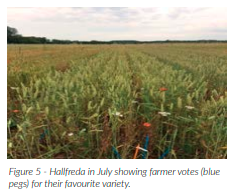
However, these varieties were imported from Austria and show that continental varieties can be susceptible to UK races of rust and these varieties must be well tested to confirm resistance in the target production environment before bringing into commercial production in the UK. That said, the conditions were perfect for yellow rust with a mild winter, followed by a warm spring and overnight dews leading to an epidemic. During 2019 higher than expected levels of yellow and brown rust were seen in some varieties. It is not yet clear if the reported cases of high yellow and brown rust disease levels in 2019 indicate the initial emergence of new rust races or exceptionally high disease pressure at some sites due to optimal environmental conditions.
Voting for preferred varieties at a trial meeting in July allowed farmers the opportunity to pick varieties based on a different set of traits and selection criteria than at the meeting in April. Varieties showing good canopy cover, a high green leaf area, low disease levels and a high expected yield (based on ear number and size) were most desirable. Hallfreda, the near market line from Sweden was the winner, mostly thanks to it’s very green and clean appearance and good canopy cover due to its high levels of disease resistance and later maturity.
Yield and Quality data
The average yield of the plot trial in 2018/19 was 3.60±0.08 t/ha. Whilst Tukey’s HSD scores show very few varieties are significantly different from each other in terms of yield (see Table 5), the varieties do tend to fall into a below average yielding generally higher quality group (particularly with respect to protein) and an above average yielding generally lower quality group otherwise summarised as a genetic yield (Y) and quality (Q) cluster. Yield and Protein show the typical inverse relationship.
The two groups are generally considered as wheats for milling (Q) and wheats for feed (Y). Looking at Table 5 can help show varieties that may buck the trend such as AWC1 (Mv Fredericia) that comes top of the below average yielding Q group whilst showing high quality for all three variables measured. Hagberg Falling Number (HFN) is a standard measurement for milling quality but is highly linked to crop phenology and ripening making it an awkward variable to include given that the logistics of a plot trial mean all varieties must be harvested together.

This means, that earlier ripening varieties will have a bias against them as they will likely come to maturity several days before the trial is harvested. While still useful as an indicator of quality, this fact should be considered when comparing HFN data. Ehogold illustrates this point well as the earliest ripening of the varieties tested and with high bread making quality attributes, it had one of the lowest HFN numbers.
Investigation of Traits
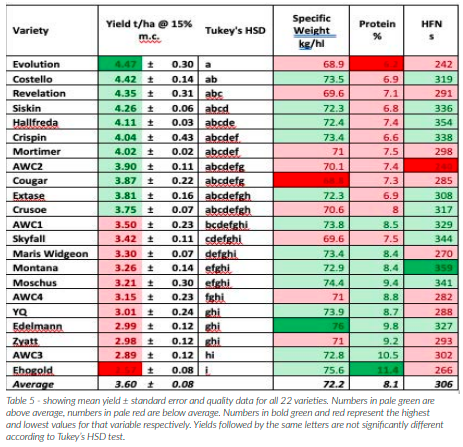
Figure 7 shows the principle components that explain the most variation in the dataset from the 20 varieties (excluding Ehogold and Edelmanm) and the 3 replicates assessed (60 plots) based on all measured traits. These principle components correlate with certain traits which are plotted on the figure and the strength of the correlation indicated by the colour (contrib: red = high and blue = low).

Of all the traits measured the height in March and April, and the relative biomass and the change in relative biomass (the difference between biomass in March and April: XBiomass) are the variables most strongly correlated with PC1. These may be considered a measure of spring vigour. Height in March and biomass in March also strongly influence PC1 while growth habit in April (GH April) also influences PC1. PC2 most strongly correlates with the change in biomass (XBiomass) and the change in height (XHeight). Variables in blue (i.e. yield, crop cover in July and Total disease) have a weaker influence on the principle components. Note that some variables have been excluded entirely from the PCA given their very weak influence on principle components.
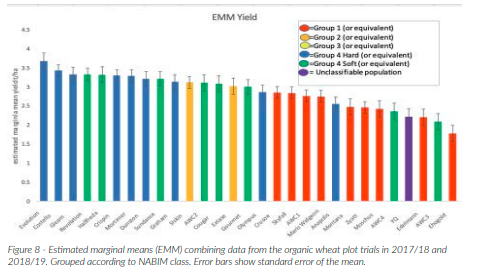
We can also look at how the different traits correlate with one another, by looking at the angles between the trait vectors. The smaller the angle the more positively correlated while the larger the angle the more negatively correlated.
Trait vectors at 90 degrees are unlikely to be correlated. Observing the above PCA shows that yield doesn’t appear to be strongly correlated with any traits. The only trait that comes close is the growth habit measured in April with a small suggestion that more prostrate growth habit may be linked with a higher yield, but this is a very weak correlation and can essentially be disregarded. Yield is negatively correlated with total disease, growth stage in April (GS.April) i.e. more forward varieties, and height in April (which will in part be influenced by phenology, since the earlier varieties will be further through stem extension and hence taller). The varieties with more biomass in April also appear to be negatively correlated with yield.
2017/18 and 2018/19 Variety Yield
Estimated marginal means correct for bias due to differences between year to provide a more accurate aggregated mean yield for each variety to enable comparison of varieties averaged across years when certain varieties appeared in only one of the years. The 2017/18 trial yielded a grand average of 2.3t/ ha compared to the grand average of 2018/19 of 3.6t/ha. This represents a yield in 2017/18 of 64% the yield of 2018/19.
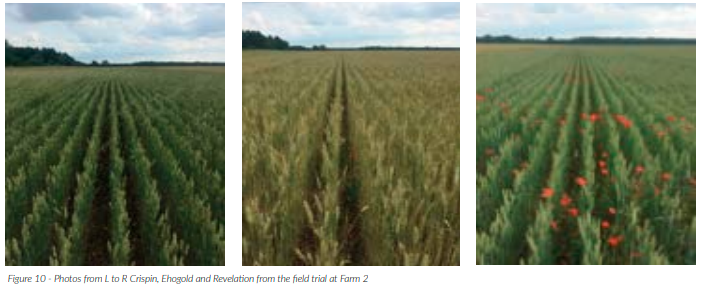
This approach has been useful in identifying varieties potentially unsuitable and hence worth dropping from the variety trial. For example, Anapolis as a group 4 falls outside the clustering of the rest of the group 4s that are higher yielding, and falls within the lower yielding, higher quality cluster of the group 1s. Similarly, new group 1 equivalent milling varieties like Ehogold and Edelman don’t appear to offer more productivity than the current collection of group 1 varieties including Crusoe and Skyfall. AWC1 (Mv Fredericia) does look to have potential for organic production after two years with good productivity and excellent quality. The varieties Mortimer and Hallfreda as hard and soft group 4 equivalents respectively also look to have good potential for organic production on a commercial scale, showing good productivity within the cluster of high yielding group 4 types.
Individual site findings; The Farm field scale trials

The three farms that each grew a selection of three to four varieties for comparison at a field scale, did so utilising farm management practices to give a more reliable estimate of commercial performance. This was linked with a wider varietal testing network supported by the LIVESEED project. When looking at the varieties grown in each individual farm, these tended to align along a yieldprotein trade-off. However, observing any individual variety across farms, there is an evident change in yield with a reasonably constant protein content.
Thus, the yield protein trade-off, generally seen as a big limitation especially for organic production, does appear across varieties within an individual farm, but not necessarily within a variety across farms (Graph 9 b). These trends are being analysed across the wider Liveseed farm network, hoping to shed light on optimal environments and management systems to help maximise wheat yield and quality. These results could help organic farmers plan their target market and hence varietal selection more effectively to meet market specifications, with some of the highest yielding farms in the wider farm network able to achieve >12% protein content, a particular challenge for organic winter wheat production.
-

AHDB Strategic Cereal Farm Week
Sharing AHDB’s Strategic Farm demonstrations and practical ‘how to’ resources virtually

AHDB’s Strategic Farm Week goes digital
Usually, summer sees each AHDB Strategic Cereal Farm host open their doors to those interested in learning about the research programmes put into field scale demonstrations onfarm. However, due to Government restrictions, this year’s programme took place in a purely digital format comprising videos, webinars and a podcast. The webinars during the week covered a range of topics including monitoring crop development, pests and diseases, reducing chemical inputs and masterclasses on crop establishment, soil structure assessments, mole drainage and soil loosening. Experts from AHDB and across the industry led the sessions including pioneering farmers Simon Cowell and Tim Parton, and soil expert Philip Wright.
This year, Strategic Farm East host, Brian Barker from Lodge Farm, Suffolk and Strategic Farm West host Rob Fox at Squab Hall, Warwickshire, were joined by a third. Farm manager David Aglen, is the newcomer having joined the Strategic Cereal Farm programme earlier this year, extending the network up to Scotland for the first time. Having yet to start trials at Balbirnie Home Farms, David is interested in looking at regenerative agricultural practices, plant and soil health and carbon offsetting through the Strategic Farm Scotland programme. David said: “There is little research going on into regenerative agriculture in the UK currently. This is the direction we want to take our business so working with AHDB offers the opportunity to harness the research available and get more work done to help us and the industry succeed in moving towards our goal.”
At Brian Barker’s farm, a lowering inputs demonstration is one of several demonstrations taking place, which was showcased during the week alongside research looking at cover crops, perennial flower strips and boosting early crop biomass. Lower input, higher margin farming, regenerative farming and soil management all came together in one of the key webinars of the week in which Brian Barker, Tim Parton and Simon Cowell took part, see the featured article. Farm manager, Rob Fox is overseeing a separate set of demonstrations in the west of the country looking at soil cultivations, the impact of summer catch crops and pests and natural enemies.
This season has been a particular struggle for Rob, who at one point was considering throwing in the towel altogether. Following a season of heavy rainfall, he struggled to get crops in the ground, let alone establish his demonstrations. As a result, a significant portion of the research programme at his farm had to be written off.
Since then Rob has soldiered on having endured, along with the rest of the country, a prolonged dry spell; going from one extreme to the other. “It’s been a tough growing year meaning we’ve had to reduce what we had planned for the season. “It’s not all been bad news though as we’ve been able to add in an additional demonstration looking at summer catch crops. We’ve planted two different mixes: one is a bought-in mix of phacelia and fodder raddish, the other is home saved spring beans and spring barley. The aim is to see if they is any benefit to the following wheat crop.” Attention now turns to later in the year, as the summer approaches and harvest 2020 beckons. AHDB looks forward to your joining us to hear about the results from all the harvest 2020 demonstrations at Lodge Farm and Squab Hall in the autumn.
To access any of the content from Strategic Farm Week 2020, including watching back the webinar videos, please visit: https://ahdb.org.uk/sfweek2020 To find out more about the host farms please visit the dedicated webpages using the links below:
• Strategic Cereal Farm East (Lodge Farm): https://ahdb.org.uk/farmexcellence/strategic_cereal_farm_ east
• Strategic Cereal Farm West (Squab Hall Farm): https://ahdb.org.uk/ farm-excellence/strategic_cereal_ farm_west
• Strategic Cereal Farm Scotland (Balbirnie Home Farms): https:// ahdb.org.uk/farm-excellence/ strategic_cereal_farm_scotland
How to decide when to lower inputs
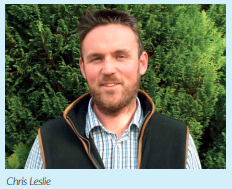
AHDB’s Knowledge Exchange Manager for Scotland, Chris Leslie, hosted the “How to decide when to lower inputs” webinar, as part of Strategic Farm Week in June 2020. Here he talks through some of the key findings and topics of conversation from the webinar, featuring farmers Simon Cowell, Tim Parton, Brian Barker and David Aglen, along with Catherine Harries, AHDB.
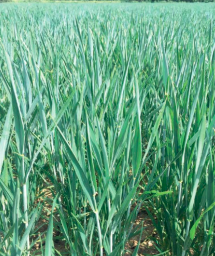
Changing systems, changing mindset and learning to work with nature were key themes throughout this webinar exploring the topic of lowering inputs. This topic is one that is being looked at across the three AHDB Strategic Farms through their demonstrations and six year programme. All of the farms are at differing points on the road to regenerative agriculture, the system of farming principles and practices that increases biodiversity, enriches soils, improves water quality, captures carbon and enhances ecosystem services.
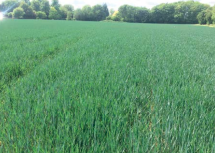
Agriculture is disruptive by its very nature. However, our three Strategic Farmers as well as Tim and Simon, aim to work alongside nature and put soil and the environment at the forefront of their farming system using tools such as IPM and no-till. Tim Parton stated right at the beginning of his presentation, that “I find when you work with nature, rather than fight nature, it works”. A key part of moving towards this system is to find ways to farm with less inputs. For Simon Cowell, this has included a range of options that have been put into place on his heavy clay farm in Essex, such as: stopping growing oilseed rape, the introduction of perennial crops such as lucerme and aiming to overlay crops through the rotation to support soil biology and mycorrhizae.
This change of the rotation has enabled Simon to halve the nitrogen used on farm, from when he was in the previous system of growing solely wheat and oilseed rape. Simon admits that “it’s difficult to back off and say I’m not going to spray any fungicide or put on any phosphate fertiliser” and understands that every farm is set-up differently, with some paying high rents and mortgages. However, the importance of getting your soil in the right condition before you start to reduce inputs was a key part of the solution. For Simon, he has been able to speed up this process by using home-made compost to enable the biology to function and for the nutrients to the circulate and more.
Simon noted that his preference is to not focus on the margins of individual crops instead, ”it’s about the whole rotation that we’re considering, its better to not think about each one individually. It’s a longer term thinking all together ”, he says. Brian Barker also discussed how he is looking at how far he can reduce inputs in his crops at the Strategic Farm East. As one example, a demonstration taking place this year on-farm is looking at reducing plant protection products and fertiliser to see what impact this will have on pest and disease pressure, crop yield and net margin. The farm has applied a reduced input programme in a field of winter wheat and will compare the results with a conventionally managed crop at harvest.

The work is part of Brian’s ongoing interest in looking at how far it is practically possible for farmers to reduce inputs. Last year he tested the natural resistance of winter wheat varieties by applying three different fungicide application programmes to see which gave the best margin. “This is all about changing mindsets as we’re going to have to look at alternative ways of protecting our crops. In this demonstration field, we ploughed it due to previous blackgrass populations, planted naked KWS Siskin seed, applied a pre-emergent herbicide, no insecticide, one PGR at T1 and only spent £14/ha on fungicides at T1 and tebuconazole at T3 due to rust coming in late.” said Brian.
“Weaning myself off using inputs hasn’t been easy and it’ll be interesting to see how this crop does. Last year the yields held up quite well; the wheat that received the lower input programme produced the best cost of production by a long way and yield held surprisingly well. Lack of moisture is clearly going to be significant this season which was similar to last year.”
For farmers starting on the journey, this thinking, following the Strategic Farm work and asking the questions of research, along with building soils might be a good place to start.

Given the extremes of the last two seasons, some farmers have looked into going back to cultivations when transitioning to a regenerative agriculture system – something that was eluded to several times during the course of the webinar by both Tim Parton and Simon Cowell. Managing these extreme weather patterns is often the difficult part when in transition, as you learn to work with or understand the natural systems. It is acknowledged that it is incredibly hard work and often years of change to take soil from a conventional system before getting to a place where the soil starts to work for you rather than against.
No one piece of machinery holds the key, with all involved in the discussions having different types of machinery on their farms. It has more been the use of synthetic inputs and often a lack of organic nutrition, which has created the current reliance on inputs. We need to start to examine how we look after our soils, so that our crops can remain green for longer when the next dry period appears. It is by doing this that inevitably allows us to reduce our artificial inputs. This webinar was just a start of the discussion and the conversations and research will undoubtedly continue.
To watch the webinar session back, please visit the AHDB Cereals and Oilseeds YouTube channel or link through from: ahdb.org.uk/sfweek2020.
For all of the details about the demonstrations taking place at the Strategic Farms this year and the results to-date, please visit the webpages at: https://ahdb.org.uk/farm-excellence.
-

Cover Crops On Trial
AHDB’s Technical Knowledge Exchange Manager, Harry Henderson, takes a look at the results from the recently published Maxi Cover Crop research findings and discusses what lessons you can take-away for your farm system.

Cover crops. You’ve read the articles of untold benefits of soil restructuring, drainage improving nutrient building, weed suppressing, disease controlling, yield enhancing, resilience building, environment saving, superhero cover crops. You’ve seen the videos online of drills working in bonnet high cover crops without issue and crimper rolls seemingly doing away with agro-chemical control. It must be a no-brainer to get involved in cover crops.
But on the 11th May this year the AHDB issued a press release and a 111 page report of a 3-year cover crop trial with the standout comment being; Cover crops were associated with an average gross margin loss of £150/ha across two consecutive arable cash crops. How could this be? I phoned a couple of my colleagues and they said ‘It is the experience of many farmers starting out using cover crops’. Clearly, a further look into the report is necessary and this publication is the place to do it. Does the report have gaps? Sure. Does the report highlight real findings and put some realism into what is an ever-evolving story? Definitely.
So, the AHDB funded a three-year “Maxi Cover Crop” project, which aimed to maximise the potential agronomic, economic and ecological benefits from cover crops through investigating different cover crop options and crop management approaches.
In a recent survey of UK farmers, the most cited reasons for not growing cover crops were:
1. They did not fit with the current rotation
2. Expense
3. Difficulty of measuring their benefit to crop production.
The Maxi Cover Crop project has shown that:
• Early establishment (August rather than September) is important to maximise the benefits of cover crops, particularly to ensure good crop cover and nutrient recovery. Typically, the different cover crops yielded between 1 and 3 t/ha above ground biomass and took up between 30 and 50kg N/ha, although up to 90 kg/ha N was recovered following early establishment at one of the sites.
• Highest N recovery was achieved by using either species that were able to fix N from the atmosphere (i.e. clover and vetch) or establish good above or below ground biomass, early in the season (e.g. radish, phacelia and rye).
• Rye produced the largest root length early in the season. Phacelia also rooted well although the roots were slower to develop. By the time the cover crops were destroyed (February), phacelia had produced the greatest amount of roots, particularly in the topsoil, and it also had the narrowest roots, suggesting it explored more of the soil for a given root biomass compared to the other cover crop treatments. There was no relationship observed between the amount of cover crop rooting and rooting of the following spring cash crop.
• Soil structural improvement from a single year of cover cropping was difficult to detect. However, at two of the tramline trial sites with medium textured soils, penetration resistance, bulk density and visual structural scores were lower (i.e. ‘better’) where cover crops had been grown indicating improved soil structure and workability. Earthworm numbers were also increased where a five species mix (comprising phacelia, oats, oil radish, clover and buckwheat) had been grown.
• Cover cropping on heavy textured soils was shown that it can result in increased topsoil moisture content, probably as a result of the vegetative cover preventing evaporation from the soil surface.
• Late destruction and incorporation of a high cover crop biomass (< 1 week prior to drilling) resulted in poor seedbed conditions for the establishment of the following cash crop, which led to lower crop yields.
• Cereal cover crops (as a single species) should not be grown ahead of a spring cereal cash crop. At the experimental sites, spring barley establishment, rooting to depth and grain yields were all reduced following oat and rye cover crops. The reason for this is uncertain, but N immobilisation, and pest and pathogen carry-over (‘green bridge’) have been cited as possible causes.
• A buckwheat cover crop may enhance P availability to the subsequent cash crop. At the experimental sites, there was a trend for higher phosphorus concentrations in spring barley grain following a buckwheat cover crop compared to the control (volunteer/weeds). It is uncertain what the mechanism is for this, as rooting by the buckwheat and total above ground biomass production was low compared to the other species evaluated.
• A single year of cover cropping does not improve gross margins. Nearly all the cumulative (2 year) margins calculated across the sites (20 comparisons) showed a reduction in margin from growing a cover crop compared to no cover crop (ranging from + £64/ ha following oil radish on a clay loam to – £476/ha following a two species mix on a clay soil). The lower margins were caused by an absence of sufficient yield increases to compensate for the additional seed and establishment costs. The benefits from changes in soil physical properties or nutrient dynamics are unlikely to appear within the 2 years of the project so the longer-term use of cover crops over a full rotation (including more than one year of cover cropping) is required to fully assess the impact on margins. Moreover, non-tangible benefits such as improved water quality, erosion control and enhanced biodiversity should be considered as a wider public good.
Tackling that headline statement of £150/ha loss. The operation costs, while representative, are at the top end of where costs tend to be.
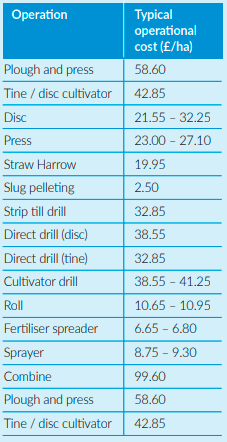
The Monitor Farm average for combining is £66/ha for example. And disc based direct drilling varies from £19 to £30/ha depending on how much land you cover with it. S,o operation costs used in the trial are 30% more than you’d hope to face.

As an illustration, at the Kneesall, Nott’s trial site, the spring oats had the lowest cumulative margin of £879/ha due to a yield reduction of 1.43 t/ha compared to control, (stubble and cereal re-growth) which may reflect the rotational conflict of growing a cereal after a cereal cover crop. The highest cumulative margin was from the oil radish which was £1256/ha, which reflected the higher spring barley yield and low seed costs compared to the other treatments. The control cumulative margin was £1192/ha. The cost of establishment of the cover crop ranged from £65/ ha (spring oats) to £118/ha (mix 3 – spring oats, crimson clover, oilseed radish, phacelia and buckwheat). It’s perhaps unfair to expect a cover crop to return on investment from yield improvement alone. Especially in year one. As we have realised at many a Monitor Farm meeting, building soil resilience is a career long objective and adopting cover crops should enable lower machine costs, much lower than used in the trials. Cover crops should also extend working windows and improve surface drainage, but again these are long term aspirations rather than quick fixes.
With all field trial work, while questions are answered, more questions are raised. That well-worn phrase ‘more research is needed’ certainly stands true in this case. And arguably a greater look into adopting cover crops into a system of changes on the farm, to lower cost, reduce reliance on inorganic solutions and improving overall farm resilience is needed.
Future research suggestions included:
• Understanding the fate of N recovered by cover crops – when this N is released and how much is released. The ability to predict mineralisation rates for different cover crop species grown on contrasting soil types in different agro climatic zones will improve fertiliser recommendations for subsequent cash crops.
• Evaluating alternative methods for destroying cover crops rather than relying on glyphosate (e.g. grazing, chopping, crimping, rolling). Understanding the limitations of techniques for managing contrasting cover crops is important to improve guidance for cover crop management and the implications for subsequent cash crop establishment and effects on soil properties and N supply.
• Evaluating the long-term (multiple cycles of cover cropping) benefits of cover crops. What are the benefits for soil organic matter, soil biology and associated soil properties.
• Quantifying the economics of growing cover crops and the potential income from livestock grazing or the reduction in inorganic nitrogen fertiliser application in the following cash crop.
• This study showed that rye and to lesser extent spring oats resulted in slower development of spring barley early in the season and lower yields at harvest. Further work is required to understand the cause of the cash crop yield reductions (e.g. nutrient availability, disease pressure, etc) and whether cover crop mixes can be developed that do not lead to reduced yields. This has implications for EFA’s which require cover crop mixes to include a cereal and non-cereal. • In this study, there was some evidence suggesting that buckwheat may enhance P availability to the following cash crop. However, further work is needed to understand the mechanism for this, and given the cost of buckwheat, how much of a cover crop mix needs to be buckwheat for this benefit to be achieved.
While there’s lots still to understand, it is a no-brainer that covered soil is good for farming, the environment and will pay dividends in the long term. So a longer term look into cover crops would the best as the next steps for research. All three AHDB Strategic Farms in Warwickshire, Suffolk and Fife, Scotland will address cover crops over their 6-year programme and incorporate them into each farms long term thinking. Make sure you check in either online with the results from these farms as they come through, or in due course, in person.
For further information on cover crops and to download the project report, scan the QR code below:

For further information on the Strategic Farms, visit: scan the QR code below:

-

Drill Manufacturers In Focus…
NEW FLEXIBLE SEEDING OPTIONS FROM KUHN

Supplementary seeder range adds versatility
KUHN has introduced a range of supplementary seeders that can be fitted to its Venta, Espro and Aurock pneumatic drills to facilitate progressive practices such as companion cropping or apply fertilisers, granular herbicides or slug pellets whilst drilling. The smallest model in the SH seeder range is the SH 1120, with a 110 litre hopper. In this case, air from the drill’s main fan is used to direct product into the venturi to enable it to be applied with seed from the main tank. The larger SH 1540, SH 2560 and SH 4080 models, with 150, 250 and 400 litre hopper capacities respectively, are equipped with their own electrically driven fans and apply product via splash plates behind the main seeding lines. All models use KUHN’s Helica volumetric seed metering system, as used successfully on their range of mechanical drills, to maximise the accuracy of output. Application rates are controlled through the ISOBUS system in relation to the forward speed of the tractor.
“The SH seeders are an effective way of adding great versatility to KUHN pneumatic drills,” says KUHN UK Product Specialist Ed Worts. “With the main drill sowing seed in the usual way, the SH seeder can be used to sow a secondary seed, such as a companion crop used to suppress weeds, add soil fertility or act as a pest deterrent, for example. “The SH seeder can also be used to apply starter fertiliser, slug pellets or a granular herbicide such as Avadex, such is its versatility and adaptability. “In the case of the Espro RC and Aurock RC, which have split hoppers as standard, the SH seeder adds a third application possibility. This allows a variety of applications to suit individual requirements and reduces the need for expensive seed mixtures.” On the larger SH 1540, SH 2560 and SH 4080 models, application rates between 2.2kg/ha and 130kg/ha can be accurately achieved alongside the application from the main drill.

Adaptable seeder offers cost effective establishment option
A cover crop seeding unit, compatible with a wide range of minimum tillage cultivators and capable of applying all types of seed, or fertiliser, at rates from 1 to 430kg/ha, is available from KUHN Farm Machinery. The SH 600, equipped with KUHN’s Venta metering unit and with the option of 16, 20 or 24 outlets from the distribution head, is designed for uniform seed spread across a 3–9 metre working width. Seed is distributed via discharge plates located in front of the cultivator roller to achieve optimum soil-to-seed contact. Precise and simple application rate settings are achieved using KUHN’s Quantron S2 control terminal, which aligns output with forward speed. Quantron S2 also monitors seed level and controls fan speed and metering unit speed. With a 600 litre hopper, the SH 600 has big bag capacity, and the machine is fitted with a ladder and walkway to allow safe and easy access when filling. The SH 600 is specifically designed to operate with KUHN’s Prolander, Performer, Optimer XL and Cultimer L 1000 minimum tillage and stubble cultivators and is sufficiently adaptable to work with other makes of machine.
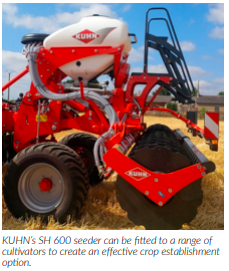
-

Farmer Focus – Adam Driver
What a season we have had! Its years like this when we can really learn a lot about our farming system and what we are trying to do.

So, it went stupidly wet stupidly quickly. We have had some really easy seasons in the past 5 years where we have been able to drill later for blackgrass control. Can we start drilling earlier again with low disturbance drills now we are on top of the problem? I hope so. Should we be growing catch crops in front of winter crops? I think this can really help mitigate some of the issues with heavy rain, catch crops will pump water in the autumn. It is often claimed they do this in the spring however from personal experience this is not true. For the autumn I think it is far more plausible as the plants are generally growing pretty fast.
Soil structure, of course is at the forefront. Better soils infiltrate more water and hold machinery (even big heavy stuff) far better than fluffy cultivated stuff. Good soil structure is at the core of what we are all trying to do and a season like this highlights that even more. There were many horror pictures of soils washing away due to poor soil management on social media. It gets dismissed as the “weathers fault”. Not a good enough excuse for me I’m afraid. Seeing these kinds of pictures and the excuses that went with them were frankly worrying and highlighted the lack of ownership UK farmers have of their problems.
Drainage is something that has come up again with a season like this. With no tilling on hanslope clay soils I think good drainage can be the difference between success and failure. We do a lot of mole draining, often in the spring and the better drained fields look so much better for it in both winter and spring crops. Some of the old drainage systems are starting to really show their age now so we will be looking at ways to either repair or replace them. I have an appointment to view a tractor mounted trencher next week. Afterall, there is loads of free time when you aren’t making dust with cultivators for months on end!
The spring as we all know, was equally ridiculous. There is no way a soil should go from being absolutely sodden to being too dry to germinate a crop in 5 days as some were reporting. Soils just aren’t working properly in many places around the country, including some of my own. These extremes of weather do appear to be becoming more regular. We need more resilient soils in order to deal with them. I discussed with a friend the other day about the regen journey we are both on. He pointed out as farmers we are so used to be able to instantly buy a piece of kit, a chemical or a fertiliser that gets us out of muddle or solves a problem, or it has in the past. What we are doing now is a much longer game. We need to focus on the core principles and not revert in panic if something goes wrong. Over time as we build our soils, gain a better understanding of the soil biology and the intricate ecology we are working with and share knowledge. Our soils will improve and shelter us from these extremes of weather and volatility of the industry.
What is the solution to all this? Keep learning, keep pushing, keep trying. There are no magic bullets!
A quick update on crops. OSR, this looks okay and will be ready for harvest in about 7-10 days (its 28th June today). I don’t expect it to break any records but has been grown very cheaply, it should offer a reasonable margin with minimal capital risked. Wheat looks average to poor. Spring crops are a mixed bag but generally pretty good. Winter barley looks well and will be harvest next week. I am looking forward to getting this years crop out the way, chasing the combine with the muck spreaders and drill planting OSR and cover crops.
UK agriculture is at somewhat of a cross roads. A red blue pill, blue pill moment. Whilst it used to be “conventional vs organic”, the regenerative group has formed. I have started to try and view the way we farm as treating causes not symptoms, conventional farming has always been about treating symptoms. This has worked well for a long time and done its job. However, we are on a treadmill in which we externalize all of our problem solving. This exports a lot of money from farm businesses. Gene editing is now being pushed by many farmers and the farming lobby groups as some kind of saviour to post Brexit farming.
They promise amazing advances such as nitrogen fixing wheat, disease resistant crops, drought tolerant crops (why we need drought tolerant crops in the UK proves how bad our soil management is!), gluten free etc. These are supposed to be provided by small UK companies. This is all well and good, but how will those companies avoid the clutches of bio-tech giants they could theoretically put out of business? It is a lovely thought that small UK seed breeders will provide wonderful traits for the benefit of the population, but I fear they will be bought out very quickly by corporate power of the bio-tech companies. What GE (and GM) are essentially trying to do is fix problems from our reductionist approach to agriculture.
The Green Revolution was touted as a scientific marvel but here we are, with the same problems and awaiting more answers to be provided to us. GE is just a continuation of the treadmill, the treatment of symptoms rather than causes, how long until GE traits get resistance? Not long if you look at what’s happened to chemicals and GM. I will be called a luddite and anti-science for saying all of this, however was it not Albert Einsetin who defined insanity as, “doing the same thing over and over expecting different results”? We are also constantly told we need to ‘feed the world’, this is one of the biggest marketing ploys pushing conventional reductionist agriculture and farmers fall for it day in day out, thus staying on the treadmill. The problem of feeding the world is not one of production, it is of distribution, politics and economics.
On the other side we have regenerative agriculture. I view this as a systems-based approach harnessing nature and understanding soil biology and plant nutrition. We all know farming has been based around the physical and chemical since the green revolution, the biological side of things has been completely forgotten until recently. Great in-roads are now being made by farmers around the world and in the UK. The problem many have with this is the simple trials we are so used to, for example X fungicide works better than Y fungicide on this variety do not work on the highly complicated ecology and biology of the soils we are trying to harness.
If a trial does not say ‘do this’ we don’t do it, its not scientifically proven right? By taking this route we begin to understand how to solve problems. Why does this crop of wheat need five fungicide sprays? Because it is nutritionally unbalanced because the soil biology is not working, because we have pumped it full of ammonium nitrate. Why do we get this weed? Because we have made the growing environment perfect for it because of our agricultural systems. Of course, none of this is quick fix, as said before there are no magic bullets. But an approach to farming that revolves around harnessing the resources we have, soil, air, water and sun in a sensitive manner for me is the only way forward. We need to be using less chemicals.
They are expensive and have unknown side effects, especially to the soil biology and nutrition we are trying to work with. We need to use less soluble fertiliser. Nitrogen use efficiency is very poor on UK farms and it has consequences for the environment. Most importantly for me, as a professional farmer running a business, all this stuff is very expensive. If we can even reduce the amount of bought in inputs by a quarter to half that we use over the next five years imagine how different financial results will look?
Which pill to take? The red pill is a continuation of the treadmill of reductionist 20th century farming where we buy in our solutions which only treat symptoms. Year in year out we do the same thing until resistance or revocation stops us. We then hope we can buy something new to replace the previous failed solution. Great for the people selling the gear, not so much for the farm finances.
The blue pill revolves around finding out the how to solve the causes of problems ourselves. It requires study and knowledge exchange, a degree of bravery and a totally different mindset. It is taking ownership of our production system. It is a mixture of art, science and gut feeling. It is a slow burner and you will not instantly see dramatic results. Over time, as proved by a growing number of farmers in the UK it does work.
The future is incredibly exciting for us. Things like BPS going become trivial when you really start to change your mindset into a regenerative one. If only the industry as a whole spent as much time and money on researching how to harness and improve soil and biology as we do moaning about the loss of neonics and demanding GE, just imagine where we could reach as a collective.
Bring it on, lets make our own luck and reclaim ownership of our agriculture.
Some useful extra reading
‘Chasing the Red Queen’ Andy Dyer
Altered Genes, Twisted Truths’ Steven M Druker

-

Farmer Focus – George Sly
A lot learned from a tough year!

13-5-12,9,0 Our farm in the South Lincs fens is partially above and partially below sea level. Last winter certainly had its challenges, we had flooding on some fields, flooding in my parent’s house and no winter crops on the farm. It was a long winter to ponder decisions for this spring. But in times of despair its often a good point to reflect on how to make changes and adapt for the season ahead. Drainage is something we will be looking ever closer at, but not in the form of all new plastic pipes. We have fantastic drainage systems in the Fens and I can only feel for the farms in the west with the floods.
Our wheat harvest was pleasing and disappointing in many ways. I have realised how important timing is on spraying, having only farmed 2 years I must admit to being a little blasé on timings. All of our wheat was no-till after forage Maize or Beet and we did have Septoria and Fusarium issues which I believe cost us 1-2T/Ha overall. It had potential to be one of our best yields. As a machine maker and Farmer I should tell everyone its all perfect, but we all know that is not true!
Our Sugar Beet and Maize proved to be a big success in terms of margin. Maize for us is a crop that we are using to try and supercharge soil health. As hard as that is to believe we utilise August until end of April to grow big cover crops, maize being a fast growing C4 plant means we can almost have the best part of the year doing soil improvement work but still make the return we need. Using strip till we keep harvest damage to a minimum and usually don’t require any herbicides, insecticides or fungicides other than Roundup at 3L. If we can drop the Nitrogen its organic electricity!
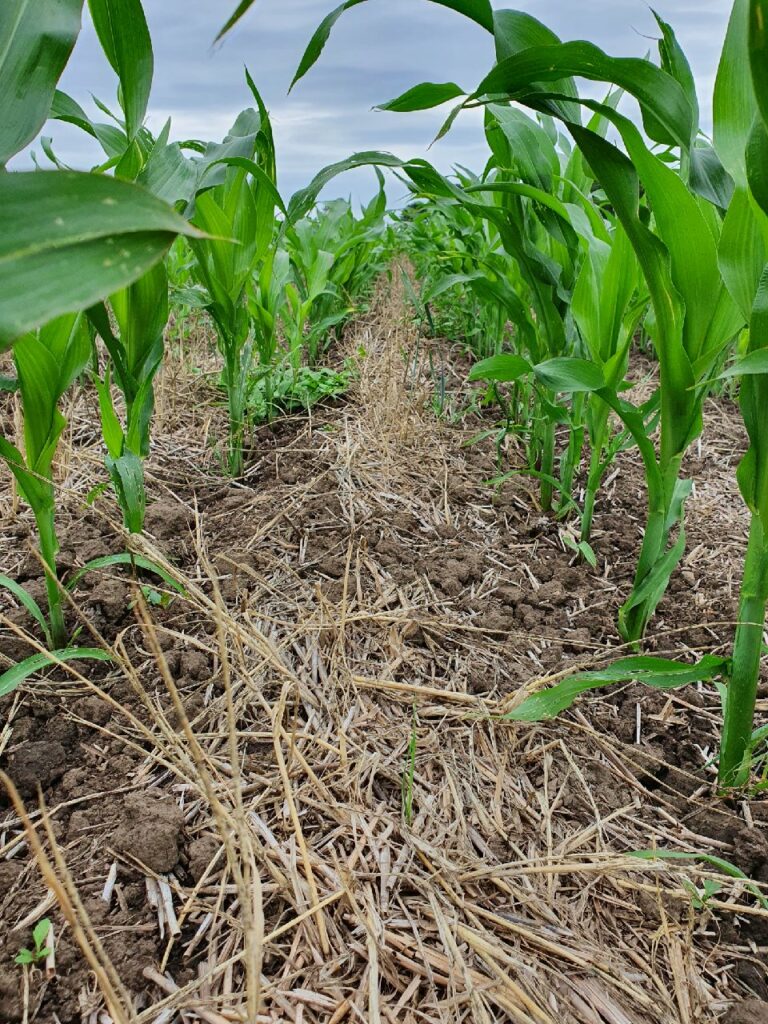
Running a multitude of businesses has its stresses and strains and I have certainly realised how stressful farming can be. In 2-3 years having the hottest summer ever, longest drought, biggest flood etc etc. But we are very lucky to be working in nature.

Clover Companions with row crops – can it replace synthetic nitrogen? Ongoing work…
We have finished a 2 year cycle with clover in row crops. Starting with Rape, then maize and we will now try some wide spaced winter cereals. We used a broad leaf white clover. We established it in June (after forage triticale) then drilled rape 25cm left or right of it, then harvested the rape. We then grazed with sheep hard. Then established Maize into it after trying various chemical and mechanical suppression techniques. Im really encouraged by it, we have seen some rather unexpected positives and negatives. But we will keep this 2 hectare trial running for 7-10 years in the hope we will find a system that can work long term. (photos of clover in rape and maize)
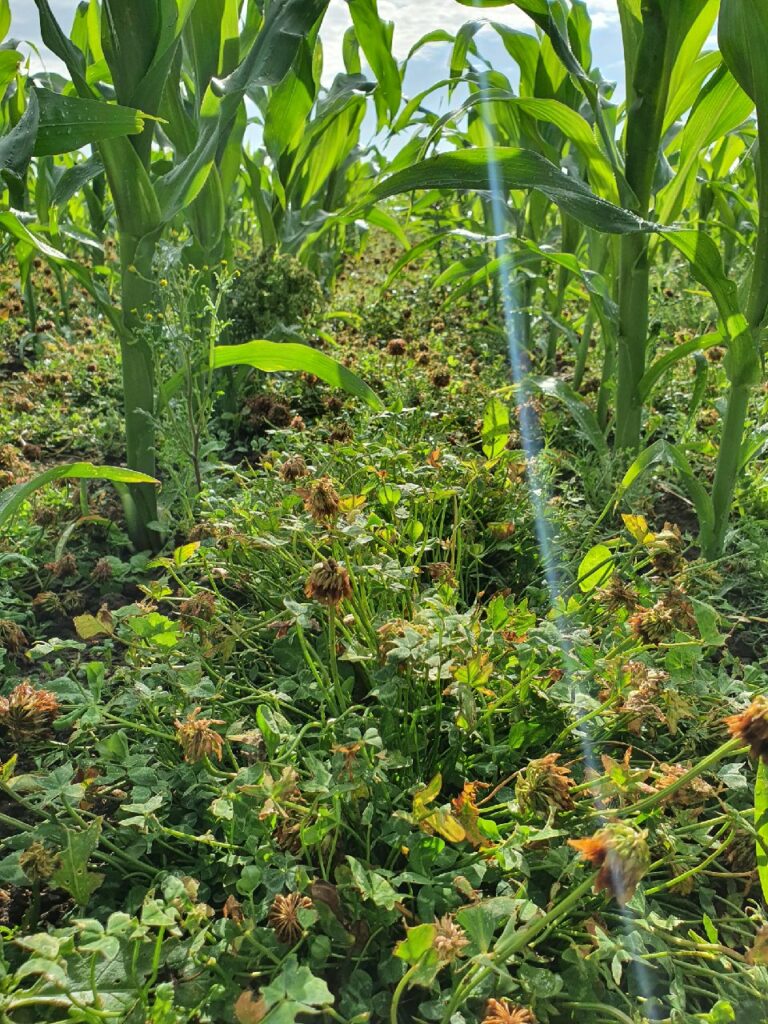
AGROFORESTRY: decision made!
After a long dreary damp winter, I looked at various options for our farm to plan it from now until 2060 when I hope to hand it on to my son. I am 34 years old, and such a decision takes a lot of thought. After many deliberations and a lot of research I have decided to put the farm into an Agroforestry system, incorporating Perennials (Trees and shrubs) with Annual crops. This will be implemented starting in Winter 2020-2021 with the first 30 hectares, and we aim to complete the planting by 2027. The system design for agroforestry has taken me almost 5 years to plan, initially having being inspired by Stephen Briggs farm nearby and a lot of inspiration from Martin Crawford and the late Martin Wolfe. I was lucky to be able to visit some farms practicing agroforestry in the UK, France and the USA to gain some experience and learn about some pitfalls to avoid.
Many people have said to me, George that sounds very risky. But I look at what we do now as reasonably high risk. Another interesting fact when planning the Agroforestry, big is not necessarily better. It would work better if we had maybe 200 acres less for my system. May this be an opportunity for farm sizes to decrease again? Probably not… but it was interesting to come to the thought of reducing in size.
Our system will involve 24 metre alleys of annual crops or rotated pasture with 4 metre under strips. We will lose around 9-11% of our land in total to the tree strips and grass strips. When I say lose… they are far from a financial loss. When the planting is complete we will be growing I believe 3-4X the human consumable calories/nutrition per hectare compared to our current system, we aim to be energy positive and carbon negative (meaning we will sequester more carbon than we emit and we will generate more energy than we consume). We will produce fruit (for drying and fresh), nuts (whole, cracked, oil, flour), berries (dried), medicinal extracts, cereals, meat, energy and building materials. We will monitor the nutritional output per hectare, calorific output per hectare and hopefully link all of that to some metrics/tracking/indices.
Protein… There is a lot of talk about Veganism, anti-meat etc. One reason we will plant nearly 2000 nut trees is that I want some of my customers to be vegan. I am not vegan, I will never be, but I want to embrace veganism and produce products to welcome them. At the same time we will turn our most successful crop (grass) that we cant digest into meat. We hope to integrate poultry in 2026 and rotate them around the agroforestry lanes.
People have said to me, what would that do to the value of our farm? For one I have decided I wont move (even if the sea comes over the wall in 2050) I am here to stay for my life. When you realise that, the value of the farm is irrelevant, and decisions get a bit easier. It will be my son’s issue. Secondly, a diverse, rich, balanced eco system is a very saleable asset and its value will grow in the future. The fens is a funny old place, flat, drained, to a certain extent man made. But it has its charm!
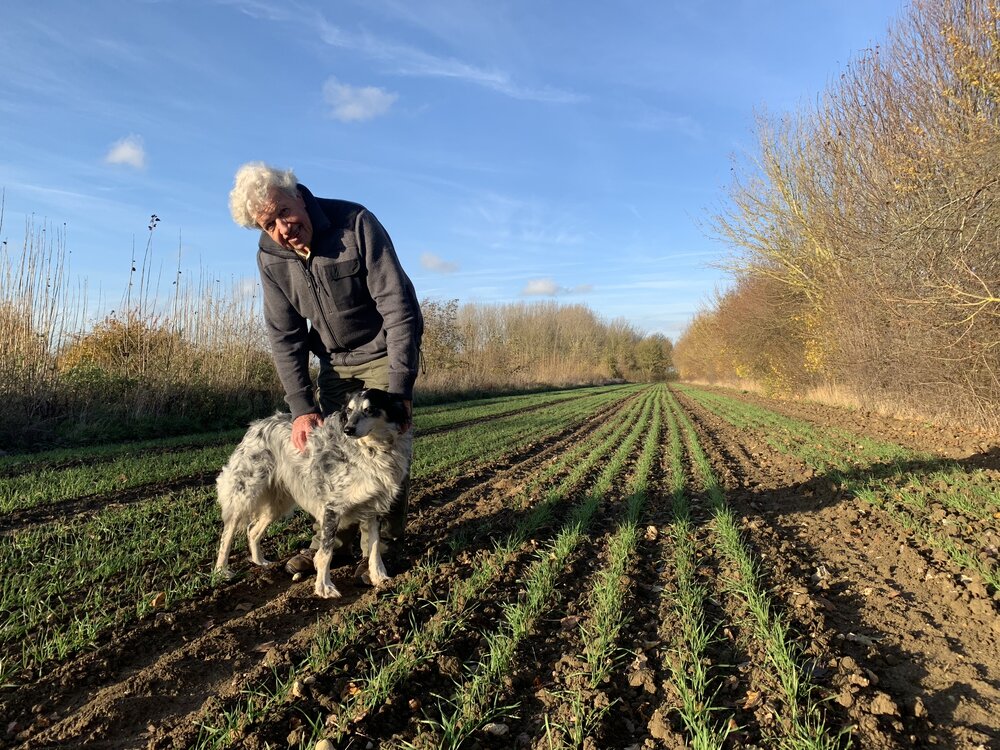
We plan to market the above ground carbon privately to industry as-well as offsetting our emissions from other businesses we own.
In future articles I hope to write more about the tree species we have chosen, why and how we plan to market them and in what form. Anything I have learned and will learn on our farm is available to others and always will be. We have such exciting fortunate possibilities in UK farming for the next 50 years and we should be excited and smiling even if it’s a bit tough at the minute.
-

Soil Workshops At The Oxford Real Farming Conference 2015
Editor Mike Donovan recalls the talk on soil at the 2015 Oxford Real Farming Conference by Bruce Bell of the Scottish Agricultural College. Delegates were asked to bring soil samples so Dr Bruce might analyse them, and the event proved so popular the room in the Town Hall was packed. Unfortunately many farmers thought it a competition to find the best soil and so he was confronted with some examples of the best in the country. A few, including your editor, decided to take samples of poor soil, and the advice was very helpful.
Visual evaluation of soil
Bruce Ball specialises in soil physics and soil management at Scotland’s Rural College, and concentrates on compaction, structure, and porosity. Bruce says “Visual evaluation is something any farmer can do, without involving expense.” Evaluation can suggest remedial action. Bruce told his audience that soil is made up of 45% minerals; 25% air; 25% water; 10% organic material; 10% roots and around 8% humus. Ratios vary through poor structure and soil type. Evaluation involves extracting and inspecting a block of soil. He said Tom Batey, a farmer who has been an inspiration to him, tells people to “observe and let the soil tell its story”.
Comparing soil from the the centre of the field with a block taken from under the fence line, corner, or other area of the field not rolled over with a tractor and/or heavily treaded by cattle is a useful exercise to see the damage which has been created over the years. Soil block extraction Dig at least a spade spit deep, and more if the field has had some deep cultivating and heavy traffic on it. The block needs to be about 6ins wide and be lifted out carefully and placed on a plastic sack. If the soil is hard it might be necessary to get the block from the side of a previous hole.

What to look for If the block has a uniform structure the signs are good, but you need to take more than a passing glance. Soil that has been affected by traffic and other use will have horizontal layers of different structure. The depth of these layers needs measuring and noting down. Breaking the soil in the block reveals more information. The first stage it to move the block on the bag gently and see how and where it fractures. This can show layers which may not be first visible, and you can then pick out lumps from different depths of the soil and take a look at their shape. Breaking lumps into 1/2in – 1.5cm – fragments will show whether their porosity, root patterns.
Shape of soil pieces It’s obvious that you want to see the soil as it is present in the field, so parts that have been squashed by the spade and boots are not representative. Similarly when handling the need is to do it gently. Angular patterns, smooth surfaces rather than pitted indicate problems. Plant roots in the block indicate the quality of the soil. Roots that are clustered, which turn at sharp angles, that are thick and short all indicate soil problems. Soil colour is very important, as that which has been starved of air goes grey, and can smell of sulphur and quite frequently there are ferrous ions present as well. Colour varies with the mineral type. Soil smell is another useful measure of structure. He described three different smells – like leaf mulch, a kind of woodland scent; like old compost which is perhaps slightly more acidic; sulphurous with a hint of rotten eggs in there, and it is the last which indicates problems.
Soil scoring
Scoring the sample starts with the ease of block extraction, the aggregate shape, roots, colour and the ease of fragmentation. Soils have a wide variation of types and qualities, and there’s no point in expecting yours to compare with the best – unless it is the best! All are susceptible to damage, and the damage will show itself in the same manner in each type of soil, which is why visual evaluation is viable.
Improving damaged soils, remedial methods
Bruce had less to say on the remedial work – but then his talk was on evaluation. Yet putting soils right was perhaps the reason for many of the audience being there. Sward lifter warnings He had some words of warning about sward lifters – the Sumo is being well advertised and we featured a home designed one from Gwyn Scourfield, in Whitland. Good grass swards have prime roots which go down a long way. If a lifter is pulled through it the roots get cut and this obviously damages the plant and so reduces grass yield. Lifted swards are also more susceptible to poaching, as the soil can be quite aggressively moved upwards, leaving it less capable of carrying weight.
Aeration with a spiker Bruce explained the value of getting air and moisture into the soil. He said that aeration was valuable, and put up a picture of the aerator your editor made in 1988! Spiking can’t harm soil. Spiking is less drastic than subsoiling and sward lifting. If the soil is damp and smears, the slits are going to be less effective than if the soil breaks like scooping cold ice cream. But the soil which is dry takes a lot more weight to get the spikes in. We used the spiker once or twice a year over the whole farm, but were far too ignorant to understand the value of digging holes and looking at soil strata. I would probably have been horrified at what I was looking at. Aerating worked well absorbing rainwater after thick slurry spreading. Heavy rain all day was going to wash the slurry into the stream, which was monitored less than a mile away for pollution. The spiked holes absorbed had the rainwater and slurry – result: a saturated field which took 10 days to get dry enough to plough, but no officials called!
Getting the camera out Taking pictures over a period of years will show the changes that happen over time and Bruce says it can be a simple way to keep a check on progress.
Broader issues
The trend has been for farmers to rely entirely on soil sampling and analysis, generally done free of charge by their fertiliser supplier. The pH, NPK and S results are a long way from what can be provided to guide the farmer to the most effective ways to manage their soil, not simply for the crop they are planting, but for crops in the future.
This report first appeared in Practical Farm Ideas Vol 23-4 Winter 2014-15

-
Is Magnesium The Missing Link?
Compelling reasons to take a good look at Mg levels in your soils and methods of raising them
Written by Jon Williams from thesoilexpert.co.ukThe result of over 700 detailed soil samples in West Wales has consistently shown a shortage of magnesium with 70 per cent of the soils depleted on the clay colloid and 48 per cent showing a shortage in the available form, and unless we carry out a detailed soil analysis this major nutrient deficit cannot be corrected. Here we consider some of the possible reasons how we have come to this situation in UK soils. For the last 70 years we have focused on PH, available P, K, Mg and the fertiliser industry placed great emphasis on the P and K without consideration for the Mg (Ref Kirkby and Mengel 1976). There is now increasing evidence of the occurrence of magnesium deficiency symptoms showing up in crops and plants which will affect crop yield and quality. [1]
Soluble Mg fertiliser is a recent discovery
One of the reasons for this was that there was no soluble magnesium fertiliser available in the UK until 30 years ago when bulk powdered Keiserite Mg So4 arrived from a mined source of naturally occurring rock from Germany.
However this was difficult to spread and sales of this soil amendment product did not take-off until a granular version arrived 20 years later, but still no manufactured compound fertilisers made in the UK contained Magnesium. Today Keiserite, magnesium sulphate and Magnesia Kanit 27%Na 11%K, 5% Mg, 12%S are available in the UK and both are approved for organic farms with derogation but there are still no compound fertilisers containing magnesium.
The role of Magnesium
Magnesium has a key role in the formation of chlorophyll and acts as the anchor for Nitrogen in every cell of chloroplast both of which help to create the dark green colour we associate with a healthy plant. However its major role is in enabling the phloem of the plant to easily transfer the products of photosynthesis, sugars down into the roots. A magnesium deficiency results in a plant with excessive leaf growth in relation to root growth and the sugars stuck in the leaf which makes the plant very light sensitive and reduces the potential of the plant to transfer Co2 via sugars to the roots and hence to the soil. As a main component of Chlorophyll it has a key role in the production of ATP the energy storehouse of the plant and activates more enzymes in the plant than any other nutrient. So magnesium is both a structural component of chlorophyll and needed for its bio-synthesis.
Soil analysis methodology
To make an accurate assessment of soil levels of magnesium as well as the other major nutrient calcium a detailed soil analysis is of paramount importance for a healthy aerobic living soil and good major nutrient balance and the important ratio of Ca/Mg established by Dr William Albrecht A healthy soil needs to have a total of 80 per cent of the clay colloid dominated by these two nutrients with the ratio being dependent on the soil texture for example a heavy clay soil having 68 per cent calcium and 12 per cent Magnesium. The detailed analysis will also provide the CEC (Cation Exchange Capacity), organic matter content and sulphate levels as well as the percentage sand, silt and clay content and so can be used as a management tool to bring balance and harmony to the living eco system which is the soil.
How to amend the soil levels?
The soil amendments of these major nutrients are based on the liming agents either Calcium Carbonate or Dolomitic limestone depending on the results found on the clay colloid and what the soil texture is in any particular soil. Where the levels of calcium and magnesium are low Dr Albrecht stated that the liming agent needs to be applied in volume as with bulk lime. Raising the levels of these two major nutrients will optimise soil microbial life. However where levels are nearer to the optimum and for farmer convenience and easier spreading granular versions of these products are now available and so they can be used on an annual basis to keep soil levels at optimum for maximum yield continuously instead of letting levels drop and making amendments of these major nutrients every five years or so as was the practice in the past.
However the situation on many farms is that Calcium levels are good and Magnesium levels low or very low. The only option in these circumstances is to provide essential magnesium using Keiserite Mg So4. When the Calcium levels fall the soil will need both calcium and magnesium, at which point it will benefit from the Ca and the Mg in Dolomitic lime which comes with a ratio of 2 parts Ca to 1 Mg. It must be noted that Keiserite supplies Magnesium in a soluble form and so will not build soil reserves on the clay colloid which is needed for optimum soil health.
Essential points to note
Ensuring that magnesium is at the optimum level for your soil type will enhance the availability of phosphorus and in particular locked-up phosphorus. Over 90 per cent of soil tests show P at very high levels. The shortage of magnesium may well be what has brought this situation about in the soils of West Wales. Releasing this phosphorus will increase the Brix index of the plant (sugar level) resulting in the plant having greater frost resistance and therefore a longer, more productive growth phase in every season. A detailed soil sample which guides us to the correct levels of these major nutrients is essential for efficient nitrogen use. This results in a reduction of the environmental impact of applying synthetic nitrogen fertiliser resulting in lower costs for the farmer and an environmental benefit: a win-win situation.
Magnesium has a key role in the enzyme activity in the plant affecting 800 enzymes and has a similar role in the human body affecting 300 different enzymes including enzymes that bring about the phosphate transfer into ATP production. It can be termed as the key that starts the whole engine!!
It is all about balance
Excess Magnesium (Mg) will reduce the aerobic level of the soil and can lock-up Manganese (Mn) which can lead to Take-All in Wheat and too high a PH created by excessive levels of these two nutrients, Calcium and magnesium can reduce the availability of copper and zinc as well as manganese. Magnesium is particularly important in the reproductive growth phase ensuring optimum fruiting of the plant. It particularly benefits the growth of legumes. Magnesium uptake is usually between 10 and 25 Kgs per hectare per year, which is a similar amount to sulphur.
Magnesium constitutes 50% of the plant’s protein level as the result of holding the Nitrogen in the leaf. Understanding the essential need for the adequate supply of magnesium in sucrose translocation is highly relevant for sugar beet and fodder beet production. Magnesium uptake can be inhibited particularly in acid sandy soils with high aluminium levels as well as hydrogen and manganese ions. High plant magnesium levels are needed in drought conditions or in soil with high potassium levels. The balance between potassium levels and magnesium levels is best in equilibrium in the soil. With excessive use of nitrogen under stressed conditions a magnesium deficiency can occur and research still needs to be carried out to find out why.
A shortage of magnesium in the crop can be amended by a foliar feed after flowering to boost seed formation and fill but is best repeated every 5 weeks. It is still not known to what extent magnesium status of crops must be raised to counter stress events which will undoubtedly increase with global warming. [2] as magnesium ensures a balanced plant with good root formation to support the above ground plant material.
So magnesium can only be considered as being a major nutrient for optimum soil and crop performance and I suggest that we all take steps to monitor this nutrient for the more efficient use of nitrogen and to maximise carbon sequestration in the soil by carrying out a detailed soil sample using the Albrecht philosophy developed after 36 years of soil science research.
The benefits for human health of adequate magnesium in the diet are such that we can boost our energy levels, have a clear mind, reduce stress, and with the stress related impact of the current health crisis yet to be assessed from the effects of lock-down and social isolation it is certainly highlighting the benefits of adequate magnesium in the diet. Research is suggesting that half the UK population are deficient and so the overall benefits to the well-being of the health of the people is paramount and farmers have the responsibility to ensure soils have adequate magnesium if they are to be considered custodians of the soil, the environment and the people they serve producing quality food for the nation.
[1] Institute of Integrative and comparative biology at the University of Leeds
[2] Cakmak and Kirkby 2007
This article includes information from a conference organised by the International Potash Institute and the International Fertilise Society and Sabanca University in Cambridge, UK on Dec 7, 2007
-

Model Approach To Improving Soil Health
The challenge for UK agriculture is to build a sustainable and profitable future under a changing support structure, and restoring soil health to vast acreages of farmland will be key.
That’s certainly the view of Rob and Jo Hodgkins, who as educated selfstarters in the farming industry have experienced first-hand the damage reeked over recent decades by modern large scale agricultural practices. Both Nuffield Scholars and graduates of the Worshipful Company of Farmers’ Advanced Business Management programme, the couple are committed to a farming methodology that has soil health at its core. Their approach includes the integration of livestock back onto arable farms, with cover crops included in a rotation that can see as many as six profit-generating crops grown in a four year period.

“We believe there is a sustainable business model that can work for a great number of arable farms, particularly where significant areas are compromised by poor soil health or by issues such as black-grass,” says Rob. “However, it requires a real change of mindset and a fully committed approach to be successful. “Through our own experiences, we’ve taken land with significant weed grass problems and poor soil structure – land that has been plundered for 20-25 years – and turned it around, making a decent return in the process.”
Rob and Jo started with just 60 acres and 200 cull ewes back in 2013 and have now built their Kaiapoi farming enterprise that currently includes 1,600 arable acres and 1,000 acres of grassland in north Hertfordshire, all on Farm Business Tenancy agreements, and 2,500 New Zealand Romney ewes. They have developed a system with a four year arable rotation, alternating winter and spring crops to help combat the inherent black-grass infestations. Cover crops are grown in between winter and spring crops, providing over-winter grazing for ewes and finishing lambs.
“We tend to follow a winter cereal with a cover crop mixture of 100kg/ha of winter oats and 5kg/ha of berseem clover, direct drilled into the stubble straight after the combine,” says Rob. “The earlier establishment makes all the difference and creates a forage crop that ewes and fattening lambs are turned onto from September.” Around 200ha of over-winter cover crop grazing is supplemented with an additional 80-90ha of stubble turnips grown on a neighbouring farm.
“We like the stubble turnips for what they provide in terms of winter fodder but we’re in an area that suffers badly with flea beetle so find them very difficult to grow,” adds Rob. “Our neighbour grows a lot of winter barley, which allows earlier drilling of the stubble turnips and this seems to make all the difference in terms of establishment.”
The combination of cover crops and sheep make a valuable contribution to soil health and fertility, adding an estimated 35-50kgN/ha of available nitrogen for the following crop, in addition to building soil organic matter. “We don’t aim to graze the cover crops to the ground as we prefer to leave some crop residue on the surface,” says Rob. “Overall, the cover crops offer great flexibility and create options “This year, for example, we’ve been able to establish winter wheat in January following the cover crop, effectively turning what would have been a spring crop into a winter crop. “That’s potentially going to be really beneficial this year looking at the value of winter cereals.”
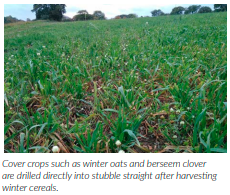
Sheep genetics
Key to the success of the system, according to Rob, is having the right sheep genetics. He’s an advocate for the New Zealand Romney, a breed that he rates due to its low maintenance characteristics, resistance to foot rot and its ability to be lambed outdoors with minimal trouble, achieving 170- 180% lambing percentage. “Our system relies on a sheep breed that we can lamb outside, so we have little requirement for buildings, infrastructure and bought-in feed,” says Rob. “We also don’t need straw for bedding, and that’s good because we aim for around 90% of it to be chopped and spread to go back into the soil as organic matter.”
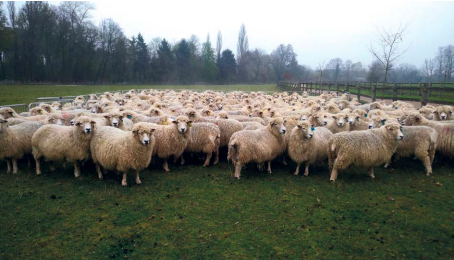
Rob describes his sheep as ‘Arable Romneys’, and that’s because they fit around the arable system, with lambing taking place in the early part of April when there’s a window of opportunity between routine arable operations. Also, with cover crops that cost as little as £30-£35/ha to grow providing ample winter feed, there’s no compulsion to sell lambs off the farm early, so instead the strategy is to make the most of what are typically better prices for finished lambs in January and February.
Quality grazing
Another key element of Rob and Jo’s system are five-year herbal leys, grown as legume and herb rich pastures as part of a Countryside Stewardship Scheme. Within their 1,600 acre enterprise, around 300- 400 acres will be down to herbal leys at any one time, these providing all the grazing from lambing time though to September when the sheep move onto the cover crops. Whilst there are some restrictions around what is grown and how the leys are managed, there are significant support payments – in excess of £300/ha – and additional grants available to fund infrastructure.
Specialist GS4 mixtures are supplied by Field Options and have been developed with maximum productivity as well as compliance as joint objectives. Testing is carried out at Field Options’ trials site at Harper Adams University, where the best performing mixture, Eco-Pasture, produced 1.3 tonnes of dry matter per hectare more than Field Options’ leading long term mixture. Put in terms of output potential, this equates to 1,300 extra grazing days or more than 300kg of additional liveweight per hectare.
“With the leys unstocked over the winter, we are lambing on covers of 1,700 – 2,000kgDM/ha, which allows us to keep the ewes and lambs tightly stocked and this minimises the risk of separation. I’m sure this helps to boost lamb survival rates and – with the quality of grazing available – they do well. “We split fields into four or five areas with electric fencing, to rotationally graze, which maximises utilisation whilst also allowing us to comply with the requirement for a five week environmental rest period.”
Adopting a model approach
With Rob and Jo’s combined expertise, the Kaiapoi enterprise is developing into a sustainable and profitable business. It’s an approach that they believe has merit in the wider arable farming industry and they have demonstrated this through a comprehensively costed model.
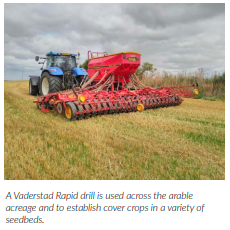
Taking a 1,400 – 1,600 acre arable unit as an example, they have shown how putting the least productive 300-400 acres into a Countryside Stewardship Scheme – and integrating cover crops into the remaining arable rotation – can create the platform for a 1,000 ewe enterprise. “We recognise the importance of expertise and have costed in a fulltime shepherd and also allowed for capital expenditure on vital equipment such as a handling system,” says Rob. “By taking advantage of Countryside Stewardship, and ensuring you have the right breed of sheep to complement the system, this can be a profitable way forward. “I think there are a lot of farms where the worst performing 15-20% of the arable acreage is generating minimal profit, due to issues such as poor soil health or weed grass infestations. Integrating livestock into the system in the way we’re outlining may well be the best way to go.”
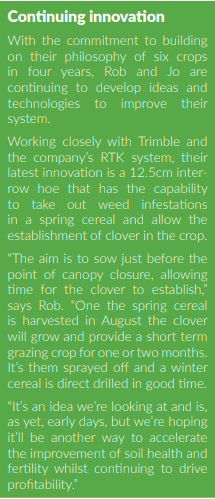
-

New Us Cover Crop Information Map Centralizes Research And Farm Trial Data
As interest and integration of cover crops accelerate across the world, the industry has been challenged in its ability to
provide easy to access, comprehensive information. Recently, a cover crop application company in the USA called GO
SEED have developed the Cover Crop Information Map to provide a free, centralized platform for knowledge exchange.
“The Cover Crop Information Map is a free resource for agricultural producers, researchers and industry influencers wanting access to unfiltered, raw research data and methodology to help them translate and apply findings to their own trials and practices,” says Jerry Hall, director of research for GO SEED. Found on gocovercrops.com and featuring an interactive map of the United States, users can narrow down available research and farm trial findings based on their geographical region and topic of interest. For example, clicking on the topic section ‘Nutrient Management’ drops pins on the map where research and trials pertain to this topic.
Clicking on an individual pin will take users to a summary page highlighting what the study was about before taking them to the full literature. “The Cover Crop Information Map currently has more than 200 pieces of research and trial summaries on 26 different topics such as compaction, forage for livestock and planting green. While the platform will be continued to be populated with previously published work, it also features the ability to add a pin, allowing individuals to add their own research and trial findings,” says Hall.
For the last 10 years, Rick Clark of Clark Land and Cattle near Williamsport, Ind., has been integrating cover crops into his 7,000-acre corn and soybean farm to reduce inputs. His continued learning and adaptation of practices has resulted in a zerofertilizer input system and a nearly 50 percent decrease in farm diesel since 2011 without jeopardizing yield. An adamant proponent of planting green into living cover crops to maximize their nutrient contribution potential, Clark’s data is featured on the Cover Crop Information Map.

“This platform is a great resource for producers wanting to get an idea of what is possible through the use of cover crops whether it be looking at published research or feature farm trials,” explains Clark. “The raw data provided will allow producers to adapt findings and management practices to suit their own unique geographical challenges and business needs to have greater success with their cover crops.” For Illinois corn and soybean farmer Andrew Reuschel of Reuschel Farms, the Cover Crop Information Map will be a useful tool to learn how other producers throughout the country are utilizing cover crops. A Soil Health Partnership Farmer, Reuschel and his father have been utilizing cover crops for nearly 20 years on their 1,200-acre farm near Golden.

“We started with a very conservative approach to cover crops by planting cereal rye before soybeans to help control erosion. For a long time, we were like a ship without a compass – it took us a while to figure things out. Fast forward to present day and we are planting our corn and soybeans green, inter-seeding into corn and utilizing mixes with up to 30 species. This has been a gradual process through speaking to other farmers about their experiences and then implementing multiple farm trials to find out what worked best for our system,” says Reuschel. “I’m excited this resource has been developed to help educate people about what can be achieved with cover crops, and more importantly, linking them to onfarm implementation.”

According to Rob Myers, Ph.D., a University of Missouri agronomist and regional director of extension programs for Sustainable Agriculture Research and Education (SARE), the Cover Crop Information Map provides a unique opportunity for users to identify research in their own area. “The Cover Crop Information Map has very helpful links to some of the research projects conducted on cover crops across the U.S. This should be a good resource for anyone seeking information on cover crops for their particular region or who wants to look at a sampling of cover crop projects from across the country,” says Dr. Myers. With a significant proportion of research being hosted behind paywalls, Hall says the Cover Crop Information Map will allow farmers to see what kind of research is being conducted outside their immediate area. “It is our hope and desire that the Cover Crop Information Map on gocovercrops.com can bring more transparency and, as a result, will lead to even greater creativity in future research projects both at the university and on the farm. By sharing knowledge, we all can learn so much more,” concludes Hall.

-
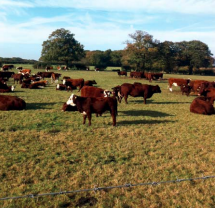
The Animals To Arable Conference – The Key Take Home Messages
Despite a break in the weather making top dressing and spraying a possibility for some, over 100 farmers and industry members made the trip to Elveden Village hall (near Thetford) last Wednesday (4th March) to hear from a range of speakers about the possibilities and benefits of mixed farming.
Hosted by Tom Chapman, Head of Regenerative Farming at Innovation for Agriculture (IfA), an agricultural charity set up in 2013 to bridge the knowledge gap between research and on-farm practice, the event acted as a ‘one stop shop’ for those looking to solve problems such as blackgrass, poor soil structure, and tight rotations.
In terms of farming sector, the majority of attendees were from mixed farms but were still running livestock and arable as separate enterprises and therefore were looking for advice on how to integrate the two into one system. Other attendees included arable farmers who were considering making the switch, and livestock farmers looking for farming partnership opportunities.

Stephen Briggs, IfA – Soils & Carbon
Kicking off the conference with a bacon roll, the first speaker was Stephen Briggs who is an organic farmer from Peterborough and also head of the soils department at IfA. Stephen started with a sobering statement that the UK agricultural industry currently faces an annual £1.44bn economic loss from soil degradation. With this in mind, Stephen then asked the attendees who would still be farming profitably without the support of farm subsidies; only 8 farmers raised their hands. Next Stephen asked who suffered from blackgrass on their farm. Over 70% of attendees said that they did.
From this Stephen stressed that these farmers “do not have a blackgrass problem, they have a soil problem”. Stephen stated that soil is the most undervalued resource and reminded farmers that “soil is refillable; it’s not too late”. His key message to improve the quality of soil was that enterprise change is necessary, and that livestock and grazing leys should be part of this mix for arable rotations. By building this resilience into soils, Stephen believes that farmers will be better prepared to protect themselves against weather extremities which are becoming common place.
Andrew Spinks, Brown & Co – How the numbers stack up
A vital aspect to consider – will it be profitable to farm with animals in the rotation? Andrew began by highlighting areas of change that are necessary within livestock only systems. The recent RBR farm business survey showed that all of the positive farm income on the majority of the UK beef and sheep enterprises was from Agri-environment schemes, BPS, and diversification. Andrew believed that to overcome this, livestock producers needed to adapt and modernise, and a way to do this could be through farming partnerships and grazing agreements. Andrew also highlighted that in 2018 only 57% of beef & sheep carcasses met specifications. So, it is clear that farmers must become more efficient and accurate when producing meat. Lower input systems, such as those seen in New Zealand should become more common place, and livestock and arable farmers can create a mutually beneficial arrangement by implementing this.
Ian Wilkinson, Cotswold Seed – Forage choice, planting the right mixtures
As always, Ian delivered a passionate and informative presentation. He started with valuable advice; “Farmers should have a low cost of production, be a seller not a buyer”. Ian pointed out that we need to consider the bigger picture when thinking about the benefits of grass leys. As nitrogen prices continue to rocket, Ian highlighted that 30-50% legume content in a grass ley can fix 200kg nitrogen per year. Anthelmintic mixes, such as chicory trefoil, can reduce worm burdens. Ian proved this by using a neighbouring farmer as an example, who hasn’t wormed his lambs for two years by using one of these herbal leys. Ian stressed that using a vast range of plants in these mixes is vital, and if this and other management changes are implemented, there is no reason why animals shouldn’t be kept outdoors all year round, whilst still maintaining welfare and achieving high protein levels. Ian’s five top tips for successful cover crop establishment were “fine, firm, shallow, sow, roll”. Ian commented that, in his experience, cattle are best for building soil fertility.
Tim May, Kingsclere Estate – Farmer Case Study
At an event such as the A2A conference, it is always good to provide farmers with information from their fellow peers. Tim is an outstanding example of the transition from a traditional arable farm to a fully integrated mixed farm. Using ‘enterprise stacking’ as the key to his farm profitability, Tim realised change was needed, having used notill systems since 1997, yet still only achieving wheat yields of 7.5t/ha. Tim stressed that he believed ‘no-till’ was only a steppingstone. He began by integrating sheep into his rotation, and from here added store cattle (he now has over 500 on summer grazing) as well as portable chicken houses, pigs and a mobile dairy. Tim has now incorporated over 500 hectares of herbal leys into his rotations. He believes that cattle are easier to incorporate than sheep due to their trainability in terms of fencing and movement, but acknowledges that TB restrictions may make sheep the better option in some areas.
Alex Bragg, Savills – JVs, share farming and grazing agreements
Alex’s key message was to collaborate to accumulate. He believes “that as an industry we are notorious for not sharing our problems or our successes.” Reminding attendees that a typical 220ha farm would see their BPS reduce by £6,600 each year, until it disappears completely by 2028, he believes that now is a real opportunity for farmers to work together to become more efficient. He advises that farmers should think of their marketplace and work backwards to consider how they could club together to demand prices, processing hubs, share knowledge and work together to secure more funding.
Mark Jagger BQP – The potential of pigs
The take up of bed and breakfast pig units has rapidly increased over the last 5 years. Mark pointed out that in terms of straw requirements, arable and pig enterprises are the perfect partnership. By farming pigs on a contract agreement, farmers can ensure that incomes are more stable and there is less risk. BQP offer 6yr contracts, which comprises 13 batches of pigs and which also includes vet care, carcase disposal, assurance, and feed.
Rob Hodgkin’s – The shepherds view
Providing another farm case study, Rob farms a mixed arable and sheep enterprise in Hertfordshire. His flock of Romney Marsh sheep, which Rob promotes as ideal for an extensive system, graze his, and many of his neighbours’ fields, twice in a 4-year rotation on a spring/ winter system. Rob advices that in this kind of system it is best to produce low cost, supermarket sheep, not pedigree winners.

He is averaging £92/lamb at 21kg carcass weights. He is getting a daily live weight gain of 365g/day from grazing oat and clover mixes. Rob agrees with the other speakers that from his experience, a rotational grazing system is key to success and stresses that to avoid poaching the sheep need to be moved regularly.
Daffyd Jones, Precision Grazing – fencing and infrastructure
Daffyd is a consultant from Precision Grazing, an advisory team of 4 seeking to encourage more profitable farms through regenerative techniques. They run farm discussion groups, trials, fencing and rotational grazing advice. Daffyd quoted that “if you hear the church bell ring twice, you’re not rotational grazing”

In terms of rotational grazing techniques, Daffyd advised that to avoid poaching, paddocks should be square. Creating long and thin paddocks means stock travel more, therefore increasing poaching. He also advised that rotational grazing on 12-24 hour shifts ensures the best gain of DM per hectare.
Tim Leigh, AQM – Marketing your Livestock
For those who do not already have livestock on the farm, many wouldn’t know where to send their finished product. Tim works for AQM, a farmer co-operative selecting the most suitable abattoirs for the breed and confirmation of the finished animal. Tim agreed with Andrew Spinks that targeting the optimum grade is crucial when aiming for optimum efficiency. He recommends farm assurance for increased marketing opportunities and reminded farmers that cereal farm assurance is separate to beef and lamb. Tim advised farmers considering cattle in the rotation to be aware of the areas they are buying them from and to consider the high-risk TB areas.
Richard Harding, ProCam – Integrating forage leys into arable
Describing himself as “an arable farmer, with all my livestock underground” Richard believes the key to conservation agriculture and sustainable intensification is a focus on soil and better utilising sunlight. He advised stripping out costs whilst maintaining productivity of cover crops by using them to ‘farm’ sunlight. He stated that this way a cover crop becomes a cash crop. Also promoting 1-day paddock grazing on cover crops, Richards key advice to farmers is to “Replace steel with roots, fertiliser with photosynthesis and Nitrogen with Nodules”.
In summary, the key take home messages from the Innovation for Agriculture Animals to Arable Conference were clear:
• Low production costs are key to profitability
• Rotational grazing will ensure maximum efficiency from grass leys, farmers should aim for a target of 12-24 hour rotations.
• The five rules of soil management are keep the soil surface covered, minimise soil disturbance, maximise plant diversity, keep living roots and shoots growing at all times and integrate livestock into your rotation
• Choose the stock based on your soil type and disease risk.
• Be open to farming partnerships. Farmers don’t need to own livestock to incorporate them into their system.
Innovation for Agriculture would like to thank all of the speakers who gave up their time to share their valuable knowledge. Their presentations and recordings from the day will be uploaded to www.i4agri.org


-

What Do You Read?
If you are like us, then you don’t know where to start when it comes to other reading apart from farming magazines.
However, there is so much information out there that can help us understand our businesses, farm better and
understand the position of non-farmers.We have listed a few more books you might find interesting, challenge the way you currently think and help you farm better.

The Fate of Food: What We’ll Eat in a Bigger, Hotter, Smarter World
We need to produce more food. With water and food shortages already being felt in some parts of the world, this might sound like an insurmountable challenge, but all is far from lost. You may not have heard about it, but the sustainable food revolution is already under way. Amanda Little unveils startling innovations from the front lines around the world: farmscrapers, cloned cattle, meatless burgers, edible insects, superbananas and microchipped cows. She meets the most creative and controversial minds changing the face of modern food production, and tackles fears over genetic modification with hard facts. The Fate of Food is a fascinating look at the threats and opportunities that lie ahead as we struggle to feed ever more people in a changing world.
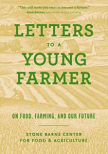
Letters to a Young Farmer: On Food, Farming, and Our Future
An agricultural revolution is sweeping the land. Appreciation for high-quality food, often locally grown, an awareness of the fragility of our farmlands, and a new generation of young people interested in farming, animals, and respect for the earth have come together to create a new agrarian community. To this group of farmers, chefs, activists, and visionaries, Letters to a Young Farmer is addressed. Three dozen esteemed leaders of the changes that made this revolution possible speak to the highs and lows of farming life in vivid and personal letters specially written for this collaboration.
Barbara Kingsolver speaks to the tribe of farmers—some born to it, many self-selected—with love, admiration, and regret. Dan Barber traces the rediscovery of lost grains and foodways. Michael Pollan bridges the chasm between agriculture and nature. Bill McKibben connects the early human quest for beer to the modern challenge of farming in a rapidly changing climate. We have listed a few more books you might find interesting, challenge the way you currently think and help you farm better.
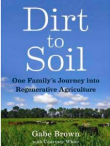
Dirt to Soil: One Family’s Journey into Regenerative Agriculture
Gabe Brown didn’t set out to change the world when he first started working alongside his father-in-law on the family farm in North Dakota. But as a series of weather-related crop disasters put Brown and his wife, Shelly, in desperate financial straits, they started making bold changes to their farm. Brown—in an effort to simply survive—began experimenting with new practices he’d learned about from reading and talking with innovative researchers and ranchers.
As he and his family struggled to keep the farm viable, they found themselves on an amazing journey into a new type of farming: regenerative agriculture. Brown dropped the use of most of the herbicides, insecticides, and synthetic fertilizers that are a standard part of conventional agriculture. He switched to no-till planting, started planting diverse cover crops mixes, and changed his grazing practices. In so doing Brown transformed a degraded farm ecosystem into one full of life—starting with the soil and working his way up, one plant and one animal at a time. In Dirt to Soil Gabe Brown tells the story of that amazing journey and offers a wealth of innovative solutions to our most pressing and complex contemporary agricultural challenge— restoring the soil.
The Brown’s Ranch model, developed over twenty years of experimentation and refinement, focuses on regenerating resources by continuously enhancing the living biology in the soil. Using regenerative agricultural principles, Brown’s Ranch has grown several inches of new topsoil in only twenty years! The 5,000-acre ranch profitably produces a wide variety of cash crops and cover crops as well as grass-finished beef and lamb, pastured laying hens, broilers, and pastured pork, all marketed directly to consumers. The key is how we think, Brown says. In the industrial agricultural model, all thoughts are focused on killing things. But that mindset was also killing diversity, soil, and profit, Brown realized. Now he channels his creative thinking toward how he can get more life on the land— more plants, animals, and beneficial insects. “The greatest roadblock to solving a problem,” Brown says, “is the human mind.”

The Soil Will Save Us: How Scientists, Farmers, and Foodies Are Healing the Soil to Save the Planet
Journalist and bestselling author Kristin Ohlson makes an elegantly argued, passionate case for “our great green hope”—a way in which we can not only heal the land but also turn atmospheric carbon into beneficial soil carbon—and potentially reverse global warming. Thousands of years of poor farming and ranching practices—and, especially, modern industrial agriculture—have led to the loss of up to 80 percent of carbon from the world’s soils. That carbon is now floating in the atmosphere, and even if we stopped using fossil fuels today, it would continue warming the planet.
As the granddaughter of farmers and the daughter of avid gardeners, Ohlson has long had an appreciation for the soil. A chance conversation with a local chef led her to the crossroads of science, farming, food, and environmentalism and the discovery of the only significant way to remove carbon dioxide from the air—an ecological approach that tends not only to plants and animals but also to the vast population of underground microorganisms that fix carbon in the soil. Ohlson introduces the visionaries—scientists, farmers, ranchers, and landscapers—who are figuring out in the lab and on the ground how to build healthy soil, which solves myriad problems: drought, erosion, air and water pollution, and food quality, as well as climate change. Her discoveries and vivid storytelling will revolutionize the way we think about our food, our landscapes, our plants, and our relationship to Earth.

Holy Shit: Managing Manure to Save Mankind
In his insightful new book, Holy Shit: Managing Manure to Save Mankind, contrary farmer Gene Logsdon provides the inside story of manure – our greatest, yet most misunderstood, natural resource. He begins by lamenting a modern society that not only throws away both animal and human manure – worth billions of dollars in fertilizer value – but that spends a staggering amount of money to do so. This wastefulness makes even less sense as the supply of mined or chemically synthesized fertilizers dwindles and their cost skyrockets. In fact, he argues, if we do not learn how to turn our manures into fertilizer to keep food production in line with increasing population, our civilization, like so many that went before it, will inevitably decline.
With his trademark humor, his years of experience writing about both farming and waste management, and his uncanny eye for the small but important details, Logsdon artfully describes how to manage farm manure, pet manure and human manure to make fertiliser and humus. He covers the field, so to speak, discussing topics like: How to select the right pitchfork for the job and use it correctly How to operate a small manure spreader How to build a barn manure pack with farm animal manure How to compost cat and dog waste How to recycle toilet water for irrigation purposes, and How to get rid ourselves of our irrational paranoia about faeces and urine. Gene Logsdon does not mince words. This fresh, fascinating and entertaining look at an earthy, but absolutely crucial subject, is a small gem and is destined to become a classic of our agricultural literature.
-

Featured Farmer – Edwin Taylor

We have been farming in South Northumberland for the past 5 generations and I am in partnership with my father. The farm is primarily mixed livestock and arable with a haulage and commercial grain drying and storage facility. The farm changed dramatically in the early 90’s with ceasing milk production of a 200 cow herd and that’s when the main focus turned to combinable crop production. Livestock has always been part of our farming business and today we run 150 suckler cows plus followers.
There is 806 ha of arable and 285 ha of grass land plus woodland. The farm sits at an altitude of 220m ranging from 20m to 300m. The soil type is mostly a sandy silty loam and high magnesium levels, which can be challenging due to our location and annual average rainfall of 750mm per year. Since ceasing our milk production, it didn’t take long for us to notice a significant difference in soil conditions with more difficult crop establishment and not realising the value of grass and fym in the farm’s rotation.
We have been on this regen/conservation ag journey since the late 90’s, without us probably realising it at the time moving to a so-called min-till system, as we were more focused on reducing costs and increasing work rates. By the early 2000’s we soon realised the damage we were doing to our fragile soils with our heavy cultivation methods and that they were not sustainable. At that point we changed our methods to a more minimal scratch tillage system with a greater focus on soil health and trying to build carbon to stabilise our soils. Previously we had removed all our crop residue so we decided to start chopping more within the rotation with the aim to leave most of the residue on the surface for soil protection and not to incorporate at depth as the residue would easily turn anaerobic. We were still rotationally ploughing at this stage probably 25-30% of the farm, mainly because of our rotation and narrow window for winter crop establishment. This continued for a number of years, while at the same time trying some different approaches to enable us to widen our rotation introducing some spring cropping.
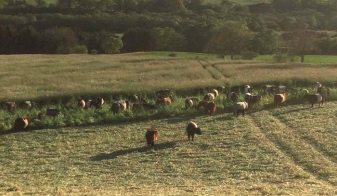
Our first overwinter cover crop was grown in 2006 just a simple oat and mustard mix cultivated in that autumn and spring beans no-tilled in the following spring, which was not that successful as due to the lack of our cover crop knowledge, the crop was holding onto the moisture and we were more concerned about the date of drilling rather than the conditions.
It was not until the harvest and autumn of 2008, which was extremely wet again where virtually no winter crop was drilled. With the prospect of having to plant 100% spring crop that was probably when the penny dropped, that if we wanted to continue down a reduced tillage system to improve our soils health we would need to widen our rotation and that would be the year to do so. The harvest of 2009 proved that we could grow spring crops successfully. We continued to experiment with cover crops, spring cropping and direct drilling till 2012, where we had another extremely wet autumn with the only winter cereals established were on those fields that had not been inverted since the late 90’s and which had applied straw, fym and gypsum over the years.

That November of 2012 another light bulb moment occurred, not knowing what to expect, I was asked to join a meeting at Newark to listen to a French man called Frederic Thomas. I came away from that meeting with a more focused direction of where conservation agriculture could take us. From that point we took the decision to move to a nearly total no-till system. Also, from that meeting we saw the start of BASE-UK as a organisation. I felt so very privileged to be asked to be involved in the organisation from the start. I have had the opportunity to meet some fantastic people over the years that are so passionate, enthusiastic and knowledgeable in conservation agriculture and in turn has given me the confidence to continue down the path that has been quite controversial and not always easy at times.
The changes have been quite dramatic both in the arable and livestock part of the business. We have moved to growing between 20-40% spring crops following our autumn established cover crops, which has also allowed opportunities to import more organic matter onto the farm in the form of compost and applying more gypsum with the compost. Our rotation has changed from a wheat, barley, oilseed rape autumn drilled to a wheat, oats, linseed, beans and oilseed rape autumn drilled, and spring drilled oats, beans, barley and peas. Also playing around with peas and oilseed rape mixes. We are still doing some cultivating probably about 5% within the rotation to level fields to improve the following crop establishment. Overall, this seems to have brought more diversity to the farm enabling our soils to become more resilient to extreme weather (still not perfect) but yet in another very wet harvest and autumn we have more winter crop established which I feel is down to the change in our methods of farming.
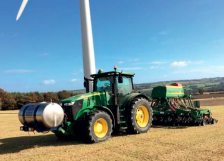
All spring crops have a starter fertiliser applied with the drill as a liquid and we have both a disc and a tine drill which enables flexibility in both winter and spring establishment. Our drive has been to try and reduce costs while still maintaining output – we have been mixing our own liquid fertiliser for a number of years, we have stopped spraying insecticides and we are trying to reduce our other pesticide use. Also home saving the majority of our seed as we have the facilities to clean and dress (recently we have moved away from applying any seed dressings with no detriment to the growing crop) which has also made life more simple as we have no seeds sitting in bags with dressing on (especially this year).
Historically the livestock have nearly always been run as a totally separate enterprise. Recently we have been growing forage rye for early grazing on arable ground where we have calved the herd in late April/early May. We are also growing westawold and clover to again graze in early April which helps clean our fields up where we have brome that is causing problems in the arable rotation, in turn is also resting our pastures so we are not chasing grass early in the growing season. It is still early days but this has given us the confidence to try some mob grazing with the herd but it is not without its problems as water and fencing are the main hurdles to overcome. On a positive note however, the temperament of the cattle has changed dramatically, they are so much easier to work with.
Looking forward and following on from a difficult autumn, I am more confident and relaxed with the quantity of spring cropped area we are going to have this year due to the experience I have gained over the past number of years. We still have many improvements to make as it often does feel like we have taken three steps forward and three steps back because of the altitude and the soil type we have to deal with but I’m sure this will improve over time as there is an awful lot more to learn.
-
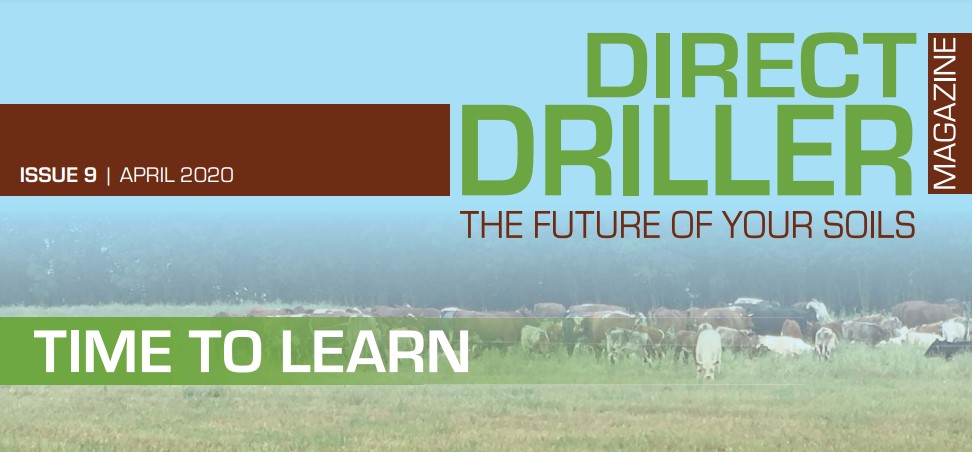
Introduction – Issue 9
No-till farmers are increasingly seeing grass as a useful arable break crop. The mat of grass roots created by No-till provides a fertile top layer of soil for the cash crop, which also benefits from the deep rooting pasture species. Grass builds soil structure and fertility, and also provides a useful income. Hence our cover picture which is used to underline the benefits and relevance of grass to the arable farmer. It also illustrates the increasingly wide knowledge base needed by farmers.
The post Brexit challenges will be immense and will require a change in the management system on many farms. Using an unchanged system will, in many cases, not be sufficient to keep the farm profitable, and it’s knowledge that’s needed to instigate change. Organisations including AHDB, Defra, Innovative Farmers, Innovation for Agriculture, LEAF, Farm Carbon Cutting Toolkit all have a stake in agri knowledge transfer (KT), as do events like Cereals, Groundswell and the agricultural shows and others, some which have sadly been cancelled this year.
KT also has a role in the universities and colleges, institutes such as NIAB, Rothamsted and many others. To a greater or lesser extent all these involve the application of scientists and the scientific method to farming problems. Direct Driller magazine, along with The Farming Forum online, is providing further reach for this knowledge, and knowledge transfer is very much the topic of the day. Our aim with Direct Driller is to bridge the gap between research organisations and farmers, providing readers with a glimpse into the future, be that making changes in time for the next harvest, or looking at methods and technology which will be used by the next generation of farmers.
The truly excellent Nuffield report on KT by Mark Bowyer published Oct 2015 exposes the major difficulties of KT in UK farming. He highlights the chasm which still exists between research and application and the need for this to be bridged in both directions. He also comments on the large number of organisations involved in R+D, each with their own means of communicating with farmers, and the ( s o m e t i m e s ) poor coordination between them.


-

Biological Farming Brings Healthy Cows To Rangemore!
Written by DJL Agriculture
It was 2010 when Nigel Roobottom and David Lievesley began to see that things needed to go down a more diverse route at Highlands Park Farm, Rangemore, nr Burton-on-Trent in Staffordshire.
Nigel and Fiona Roobottom secured the tenancy of the farm, previously farmed in hand by Lord Burton, Rangemore Estates in 2003, the 450 Acre farm, which was home to The Baileys Herd and is currently home to Nigel & Fiona’s 180 cow herd of Holstein Friesians. As of many Estate Farms, through the years of intensity the soil was very much taken for granted with two dairy herds and an Arable Unit, the fertilizer bag was very much at the forefront of the soil plan. With an abundance of slurry, which in those years was a waste disposal task there was a huge biological imbalance in the making!
When the Estate was tenanted out and Nigel Roobottom began farming the farm in his own rights problems started to appear in the cows. Nigel, a very passionate grazer of cows wanted a system that would lend itself to a relative, no nonsense management strategy. With an all year-round calving pattern back then, metabolic problems appeared at calving, leading to the cows not being able to get up.

Nigel, working together with Dave Leivesley began thinking out of the box with Dave Leivesley’s philosophy of you can’t fix a cow in three weeks, that meaning many people think that three weeks before calving is the Holy Grail. Whilst being important it’s also critical to manage the calcium element of the farm and the cows throughout the lactation. We began to recognise the lack of worms, with the slurry being spread with an umbilical cord splash plate. The decision was taken in April 2007 to invest in a Dribble Bar Slurry Tanker to give more flexibility to the system and to be able to apply slurry at optimum application rates.
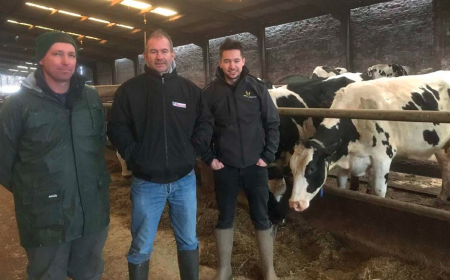
Dave Leivesley who has worked with Nigel for many years and focuses heavily on the synergy of soil sample results to health of the cow, wanted to look also at aeration as oxygen is a vital component of soil health. The slurry lagoon was already treated with Bacillus based slurry additive, designed to create a homogenous Aerobic manure. Which in Dave and Nigel’s terms was like feeding the land Bio-yoghurt. To back this up it was then decided to invest in a slot aerator in partnership with a neighbour to help get more air flowing through the heavy soils.
With Calcium very much in the mindset, the fertiliser aspect was then looked at and we turned our attention to C.A.N (Calcium Ammonium Nitrate) with Dave’s knowledge indicating that 1kg of N displaces 3.5kg of Ca, so we need to keep topping up that calcium for the health of our stock. It is my belief that when the Ph of our land drops below 6.4 we leave ourselves open to disease, and with the modern cow becoming a “pin cushion” for the vaccination needle we believe our land should be pro-biotic supporting the healthy bacteria which build up in our immune system.
The journey of biological farming began to gain pace with Nigel and Dave already seeing cow health in a better place, milk quality on a rising level with butterfat and protein increasing, Somatic cell count lowering and body condition in a healthy score. With a mixed farming approach, the forage make-up of the feeding plan is made up of grass silage mixed with arable silage, that being of an Oats and peas mixture and barley being grown in the rotation. Also, oats are used heavily in the plan, with their phosphorus scavenging property and peas, a legume fixing organic N into the soil. The crop protection piece of the biological jigsaw is the job of Daniel Leivesley, Dave’s son, who is a Biological Agronomist. Turning his attention to Bio-Stimulants and Carbon-Based foliar feeds and away from the chemical story!
The crops are drilled using a SimtechAitcheson T-Slot Drill, with the plough being sold a number of years ago! The Simtech has proved a great asset to the farm, with the T-Slot allowing air around the seed aiding germination. A front tank is currently being constructed on farm, giving the option to feed the seed with Bacillus Bacteria when it is placed in the soil. That in mind the attention turns to plant diversity within the grazing leys, with the focus on root zones, Dave creates his own ‘Grazing recipe’ with alternative thinking and herbal mixtures featuring heavily in the system. Species such as Chicory, Rantain, Clover mixes and Traditional Grasses such as timothy are included alongside Diploid and Tetraploid Ryegrasses. It is important that we have root zones at varying depths to both create aeration and mineralisation, the important part of Carbon Sequestation is for the soil to have a canopy, thus creating better photosynthesis and reducing Carbon Loss.
With few words passing by without the word ‘Calcium’ appearing again, Gypsum is very much on the shopping list at Highlands Park. To aid these high magnesium index soils, Organic Gypsum is spread in a rotation at 1 Tonne to the acre using the farms Bunning Rear Discharge Spreader. This can be seen on Dave Leivesley’s website, www.djlagriculture.co.uk, the focus being as a soil conditioner , but only mined organic Gypsum is used as a strict measure.

The concentrate element of the cow ration is also a key feature in what we call the Bio System, with Dave saying, feeding the soil is like feeding the cow and the importance of Amino Acids. This makes up the Bio-Circle says Dave, with ingredients such as Prairie Meal, Sugar Beet Pulp and other healthy components. My thinking is that if we focus on By-products so readily available to us the soil is the end user and that’s not necessarily healthy. If we focus on quality amino Acids the soil benefits via the manure. Back to the slurry tanker, where the dots are joined again the Dribble Bar System allows slurry, which by appearance and smell is a ‘Health Option’ and is placed in the sward when the timing is right, and conditions allow.

The fertilizer has been significantly reduced with F.Y.M and slurry being an asset to the farm. The F.Y.M is also taken very seriously with yards being cleaned out, the manure is stacked and turned in the same way as compost, with organic matter being high on the list. You can actually see the healthy fungi within the manure, this is only contributing to the healthy mychorisal present in the soils. Today’s heavy focus on reducing antibiotic usage is a very important goal. It is clear that our cows and youngstock are of a high health status, with the system having been implemented a number of years ago. It is also clear that this is the route to sustainable farming and food production.
Recently humates were brought into the story, with Leonodite being added to the dairy and youngstock ration and as an experiment Humic Acid was added to the biological silage additive and applied to the whole crop oats and peas. With Humates forming part of the antiviral chain and consequently finishing up in the soil. It is the way forward in creating total natural immune defence mechanisms. Coming from the early years of taking on the tenancy when the cropping, as of many farms, was wheat, maize silage and grass silage. Where grass remains the wheat and maize have been replaced with the more sustainable crops mentioned earlier.
Due to the change in cropping and farming system, the livestock can enjoy a calmer, stress free lifestyle. Being able to change the calving pattern to capitalize on the milk contract has brought about times where the system is less demanding on labour, thus giving a better lifestyle all round. The ability to add cover cropping into the system has allowed the drill to furthermore add to its benefits, whilst creating plants that pump minerals at every opportunity. With the herds grazing heavily for many months of the year it is obvious that the potash indexes have to be taken seriously. One problem that came up a number of years ago was the selective grazing by the cows. This needed some ‘out of the box thinking’. The sodium element was being supressed by the extensive K index and again needed to be taken seriously.
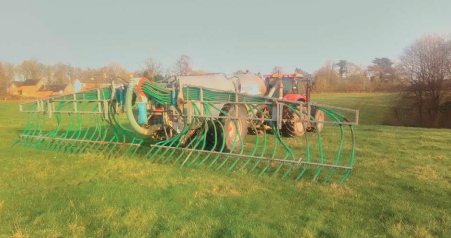
It was decided that a Carbon-based molasses foliar feed was applied through the sprayer, with the soil being a living medium we needed to ‘feed the bugs’ just like you feed a cow’s rumen. The sugars being systemically taken through the foliage and into the soil system had marked effects on grazing palatability making the sodium element more readily exchanged. This is protocol that will continue as part of the management plan. Currently the farm is achieving a yield from home grown energy. With a young herd, 30% being in their first lactation, and an 8500 litre lactation calving interval of 388 days and a yield from home grown forage, around 4000 litres, it is fair to say that the mixture of regenerative farming and dairy cows go hand in hand.
In summary and ten years down the line, the land and cows are in a great place. Challenges do crop up as they do in farming, but it is fair to say that with managing biology, problem solving is way down being replaced with positive thinking.
-

A golden opportunity to help shape agricultural policy
Written by David Kennedy, Director General for Food, Farming and Biosecurity at Defra
Many readers will have contributed to our “Health and Harmony” consultation on future farming policy in the spring of 2018, when we travelled across the country to gather views from all farmers – receiving over 43,000 responses.
Now we are once again seeking views from farmers and land managers as we design our new Environmental Land Management Scheme (ELM). This scheme will see farmers paid for work that enhances the environment, such as tree or hedge planting, river management to mitigate flooding, or creating or restoring habitats for wildlife.
As readers will know, we are moving away from simply paying for the total amount of land farmed, and ELM will be the cornerstone of our vision for an agricultural policy that pays “public money for public goods” that benefit society.
Now that this government has secured the parliamentary majority needed to proceed with the Agriculture Bill, which we launched on 16 January, we expect our new domestic legislation will become law by the summer, meaning that the agricultural transition period can start in 2021, which is when we also plan to start the ELM national pilot.
Before then, there are a number of opportunities for you to have your say in shaping this agricultural transformation.
Tests and trials
First of all, I would like to thank any readers who may be taking part in one of our ELM ‘tests and trials’ or have expressed interest in involvement.
Through these, we are testing various approaches to understand if and how they could be used as part of the new ELM scheme. These include the content and scope of land management plans, the role of advice and guidance, how to encourage farmers and landowners to work together in the schemes, and what payment methodologies could work best to deliver results and value for money.
The tests and trials we have contracted so far are helping us to test particular elements of the new scheme before putting these into practice.
The national pilot, which will begin in late 2021, will be when we start to work out how these building blocks piece together. Ahead of that, we want to do a wider call for information to harness farmers’ experiences and to learn from those, to ensure we do not repeat the mistakes of previous schemes.
A three-tiered scheme
On Tuesday 25 February we published the ELM discussion document on Citizen Space, which sets out our ambition for a scheme in which anyone from any farm or land type might participate at the right level. This stems from our early thinking and engagement with stakeholders on how elements of the new scheme might work.
An important design element we are seeking views on is having three tiers to ELM, which will ensure there is something for everyone.
Tier one would focus on encouraging environmentally sustainable farming and forestry, including actions the majority of farmers can take across their farmed and forested land – such as planting wildflower margins, improving the health of their soils, or using cover crops.
Taking into account the diversity of our landscapes in this country, tier two would be designed to support farmers, foresters and other land managers deliver locally-targeted environmental outcomes. This would appeal to those who are interested in taking on targeted environmental challenges and collaborating with others in the local area to achieve benefits on a greater scale, undertaking work such as tree planting, creating habitats for wildlife, or natural flood management.
Tier three would look to deliver transformational land use change, such as large-scale forest and woodland creation, peatland restoration, and the creation of coastal habitats such as wetlands and salt-marsh. Eligibility for this tier is likely to be project-specific, to ensure the land use change is delivered with the right natural capital assets and at the right scale.
Have your say
We have a 10-week window from 25 February to 5 May for contributions to the ELM discussion document. There will be regional events happening over this time which will be advertised on the Farming Forum and on Defra’s Facebook page, but if you can’t make it to an event, anyone can contribute to the discussion on Citizen Space, where the document is hosted. Search “Environmental land management: policy discussion” to find it.
We value your experience, whether that is from EU-administered schemes including Countryside Stewardship and Environmental Stewardship, or from other local work done with your Facilitation Fund group. Wildlife and nature groups may have valuable insights we need to capture to ensure the scheme delivers effectively for local environments, ensuring value for money for the taxpayer.
Most of all, we need this to be a scheme that works for farmers, the people who are managing the land in this country to produce food and protect nature. ELM is a golden opportunity to reset farming policy in England, and I hope all farmers can seize this moment to help us shape the future of farming for this country.



-

Have We Forgotten How To Nurture Nature?
Written by John Meadley from the Pasture Fed Livestock Association

“Humankind, despite its artistic and technical abilities, sophistication and accomplishments, owes its existence to six inches of soil – and the fact that it rains”. That phrase, attributed to Confucius (551 – 479 BC), reminds us that soil is the most basic, vital and precious medium – without which humanity could not exist. We are taught at school that the plants that live in this soil convert sunlight, through photosynthesis, into sugar. But just as man does not live by bread alone, so plants do not live by sugar alone. Much of this sugar is passed down to the roots where it is exuded out into the plant’s rhizosphere – the film of soil immediately surrounding the roots. Just as we humans are dependent upon the vibrant and complex fauna and flora in our gut (our microbiome) to digest our food, so plants are dependent upon the fauna and flora (their microbiome) in their rhizosphere to convert their photosynthesised sugars into the myriad of metabolites that they need to grow and to protect themselves. In order to thrive and engage with their microbiome, plants need a strong, healthy root system with a large surface area.
As we continue to cultivate the soil we would be wise to remember that plants and animals were able to feed, protect and reproduce themselves long before man came on the scene and that soil co-evolved – without any help from man – together with grasses, shrubs and trees, with the flora and fauna that lived around their roots and with the animals that grazed on them. What can we learn from that? Most important is to recognize that when we cultivate the soil and harvest the subsequent crop we destroy those symbiotic relationships, break up the mycorrhzal pathways, oxidise the organic matter, dry out the soil and reduce its fertility. The soil needs then to be healed. Farmers have realized this since time immemorial – recognizing the need for fallow, rotation and grazed pasture. Way back in 35BC the Roman poet Vergil wrote (translation by C Day Lewis):
See, too, that your arable lies fallow in due rotation,
And leave the idle field alone to recoup its strength;
Or else, changing the seasons, put down to yellow spelt
A field where you raised the beans with its rattling pods
Or the small-seeded vetch
Or the brittle stalk and rustling haulm of the bitter lupin.
For a field of flax burns up a field and so does an oat-crop,
And poppies drenched in oblivion burn up its energy.
Still, by rotation of crops you lighten your labour, only
Scruple not to enrich the dried-up soil with dung
And scatter filthy ashes on fields that are exhausted.
So too are the fields rested by a rotation of crops,
And unploughed land in the meanwhile promises to repay you.
Beans, Vetch and Lupins – and later he refers to Lucerne and Lentils – are all nitrogen-fixing legumes, the benefits of which they were aware almost two centuries before Linnaeus introduced the concept of botanical families – including the Leguminosae (now Fabacae). Having already recognised the importance of animal dung (….to enrich the dried up soil) later Vergil writes about grazing lush young cereals….. Another, for fear the cornstalk should wilt under the ear’s weight, Grazes down the exuberant crop while yet its young green Is barely showing above the furrows.
For centuries the concept of rotation, and the virtues of legumes, has been recognised by farmers. During the eighteenth-century Viscount Townsend (Turnip Townsend) encouraged roots and pasture within his four-course rotation – with ruminant animals as the centre-piece; sheep folded on arable crops and both sheep and cattle grazing on pasture. This fouryear rotation had two major effects on agriculture. The first was that the harvest increased in yield.
In 1705, England exported 11.5 million quarters of wheat (approx. 13,000 tons) . By 1765, wheat exports had risen to 95 million quarters (107,000 tons). The second effect was that livestock, which no longer needed to be slaughtered before the winter months, increased in both quantity and quality.
In 1891, Armstrong College (together with Cockle Park Farm) was established, later to become the Agriculture Department of Newcastle University. In 1896 it started a series of trials to improve grassland that ran for more than 60 years. Key to their success was the introduction of wild white clover (WWC), which greatly out-yielded the commercial strains of white clover then available. Together with the application of basic slag (a phosphate-rich bi-product of the steel industry) and the Cockle Park Mixture (Ryegrass, Cocksfoot, Timothy, WWC and a range of herbs) this transformed the productivity of millions of acres of pasture across the UK. Speaking at the Farmers Club 100 years ago in May 1920 , JGG Rea CBE (later to be the chair of the Northumberland War Agricultural Executive Committee) noted:
“I had some land adjoining a moor which was reclaimed by my grandfather. It was kept in cultivation almost entirely for the sake of growing roots for the sheep. We looked upon the corn crop as a necessary evil and 30 bushels an acre was considered a good crop. After an application of 1.5 lbs/acre wild white clover the grazing was what I considered phenomenal, and when the pasture was ploughed out after two years the yield was 71 bushels. Not only does WWC increase the yield, but it cleans the land to an extraordinary degree…its seems to have such a dominating effect that after a course of two seedings the land is completely free of twitch”
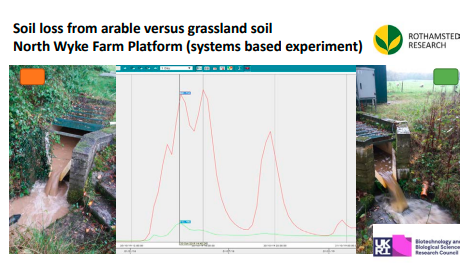
Have we forgotten these early lessons about the benefits of grazed, biodiverse pastures? Until around 70 years ago farmers focused on working together with nature to maintain soil fertility as well as both soil and crop health. This changed as WW2 brought pressure to produce more food and with the introduction of a range of synthesised chemical compounds. Much grassland was ploughed up to produce crops ……and also because it was no longer needed to feed horses – reflected in Harry Ferguson’s mantra that: “One third of the land cultivated by horses is used for growing their fodder”.
Although UK farmland is still two thirds pasture, there are increasing numbers of ploughed acres that not only do not enjoy the benefits of biodiverse pasture but are left as bare soil for extended periods. Nature doesn’t do bare soil – for several reasons. Firstly, Nature seeks efficiency and it is the colour green, not brown, that photosynthesises. Secondly, as is evident from this photo , soil under vegetation, particularly biodiverse, grazed pasture, builds up the organic matter in the soil which in turns builds soil structure, improves both water holding capacity (150,000 – 225,000 litres of water per 1% organic matter) and drainage and both retains and releases nutrients. Further, as is evident from any train window and from the graph below from North Wyke, bare soil washes away. Given that soil is the single most important and irreplaceable capital on a farm, allowing it to wash away is little short of giving people both your credit card and PIN number – a view influenced perhaps by spending my formative working years in southern Africa in the 1960s when installing and maintaining soil conservation measures was mandatory and soil erosion was considered a criminal offence.
Since WW2, farmers have been increasingly seduced by technologies that promise to increase both yield and income. As is evident from the continuing downside of the green revolution in India (whose short-strawed cereal varieties require fossil-fuelintensive nitrogen and large quantities of increasingly scarce supplies of irrigation water) – technology can be a mixed blessing, particularly when it results from reductionist research focused on single issues. This is most dramatically demonstrated in the graph below which shows the effect of Green Revolution technologies on farm income in Canada from the end of WW2 to 2002.
During this period various technologies were introduced – tractors, fertilisers (application increased by 20 times), herbicides, glyphosate, GPS and GMOs – but whilst gross farm income increased, net farm income decreased – the balance going to those who made and supplied the technology and to those who marketed the increased volumes of harvested produce. Further, in order to achieve this negative outcome, the farmers became more dependent upon the bank manager to finance their inputs whilst making less use of the freely-offered benefits of Nature. To take just one example – Nitrogen. Giving bagged nitrogen to a plant is like giving a bar of chocolate to a child. It gives a sugar rush that can make us lazy in seeking a balanced diet. The nitrogen-high plant generally has smaller roots that reduce its ability to seek out micronutrients from the soil and to withstand drought. This is bizarre when nature provides us with so much without charge – as is evident in this figure.
Mankind in general, and farmers in particular, are totally dependent upon soil. It is still the world’s single largest terrestrial store of carbon. Depending upon soil type and how it has been farmed, <70% of its carbon has been lost through cultivation since the industrial revolution, offering the opportunity for that lost carbon to be reabsorbed. It behoves us to manage this precious soil, and the life within it, as if it were our own children – life which is reflected in the soil’s organic matter…….lost when cultivated and increased when covered by vegetation for extended periods of time. Cover crops are a great step forward, preventing the soil from lying naked and exposed to both the drying rays of the sun and the damaging impact of rain. But when that vegetation is biodiverse pasture grazed by ruminants then the pasture becomes a pump that sucks the carbon into the soil – with all the benefits that this brings.
That many farmers have moved away from keeping ruminant livestock is in part due to the animals’ need for 365 day attention and the need to specialise in order to survive in a world of cheap food; but it may also reflect livestock becoming increasingly the target for much public opprobrium – accused of being a major cause of climate change. That perception is beginning to change. This is in part due to the changing understanding of methane and because the oft-quoted Livestock’s Long Shadow has been increasingly discredited .
Recent work on nutrient density at Rothamsted and elsewhere has shown that beef and lamb are significantly more nutrient dense and bioavailable than most plant foods. And further that meat produced from ruminants raised wholly on pasture is likely to be more nutrient dense than that raised on grain, and in many cases carbon positive. Whilst that may not yet be reflected in consistently higher prices for wholly pasture-fed meat, it will not be long before consumers will have access to hand-held meters that can instantly assess the nutrient density of the foods that they are purchasing in store . This will disrupt and transform the way in which farm produce is assessed and priced and should significantly increase the recognition of the benefits of wholly pasture-fed produce.
Technology has provided many products (both mechanical and chemical) and services (the capacity to communicate, record, analyse and plan). Seduced by the products of technology, we seem to have forgotten so much of the innate knowledge that farmers had a century ago when nurturing nature was the only option. In this increasingly uncertain world, we have the opportunity to relearn that historic knowledge using the best that technology offers us whilst bringing back the “muck and magic” and the “golden hoof” of ruminant livestock that can enrich the soil – courtesy of nature.
A couple of years ago I was at an event with the late Peter Melchett, then the Policy Director of the Soil Association. In response to a question about his farm, he replied: “I may be a vegetarian, but I could not farm my land in Norfolk without livestock?” I sense that, as we move forward in an increasingly uncertain world and with an increasing focus on public payments for public goods, we will begin to make a shift back towards farming being more of a conversation with nature in which biodiverse pasture grazed by ruminants plays a vital role.
